#Also books referenced include:
Text
At The Superstore…

“Then he’s like: “Since we’re gonna be partners, isn’t it also MY equipment?” And I’m like: “No, Bradley - That is not YOUR equipment! Can you believe it Keith?”
“Ok, what do you want, Kid?”

“Um… I want those.”
“Yeesh - Looks like clay. Eh - We’ll get them.”
——
Meanwhile at School….
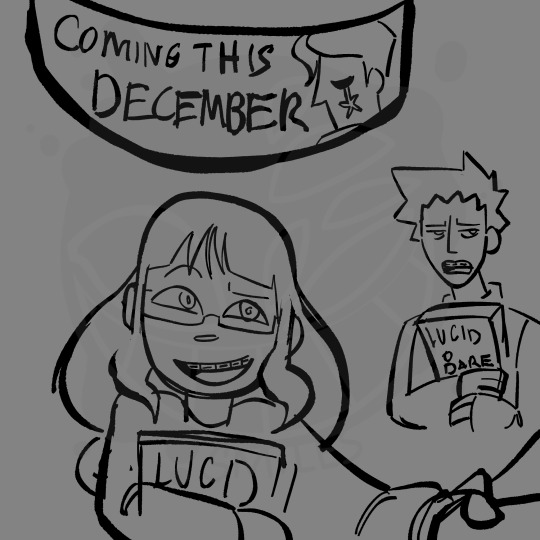
“Hey Hey - Isn’t it the Main Lady of the stage? Are you ready for your role at the premiere of Lucid O’ Dare? Be sure to come in practice days!”
“Hey Margo! Aw thanks! Glad you got the role of stage manager! Can’t wait to see your works!”
“Ugh… Stop making these two jobs sound boring!”
“…Todd.”

“You’re playing as Drescella? Niiiiceee.”
“What? You want to see me as the “Princess of your Dreams”, Munroe?”
“Shuttapp, Abs~”
——-
Meanwhile Meanwhile at The Morris House

“MOOOOOM! Why do we have to make EVERY meal for Thanksgiving? Can’t it just wait until it’s a week before my birthday?”
“Now Now, Luke - Ms. Jackson and Mr. Mennis will be here to help us cook. Now don’t complain about your birthday or no triple-shot-flavored cake—“
“Wait what?? Hang on, I’m coming to help!”
#goosebumps#horrorland#goosebumps horrorland#Mysteries around#art#goosebumps fanart#fanart#Upcoming possible events: A couple of musicals and a cat#Maybe#Who knows which one I’ll start#owo#Also books referenced include:#The phantom of the auditorium and go eat worms#oc included
7 notes
·
View notes
Text

The love of the Wanderer is to wanderers.
#em draws stuff#travel light#this image has been about a year in the making (I wanted to draw it when I first read it but I only got to it now)#my thoughts on travel light are. well they are this image primarily.#been a while and a while since I drew in this style and it feels GOOD to be doing it again!!#wish I'd figured out a way to fit steinvor into the composition but it was a hard squish even to include tarkan der (and he's very tiny)#the way I've done the mountains are purposefully referencing one of the earlier covers of the hobbit as I love jirt's painting style#and it seemed apt for various things about the way travel light exists and the kinds of things it has to say#it is right on the edge of where legend meets life when it comes to depicting early medieval europe and it's. well. read it actually.#book that makes you want to listen to 'to holmgard and beyond' by turisas except exactly backwards#(in the varangian way they are going the other direction and also they are much more (to put it as halla would) dragonish about it)#song I first heard in the context of an absolutely wild 8tracks playlist in 2015 which changed my music taste forever. anyway.#really I must read more naomi mitchison except that no library in the entire state of california appears to have a copy of the big house :/#anyway anyway. if I ever get my own copy of this book I Will be rebinding it to have this for a cover I like it so very much
59 notes
·
View notes
Photo

2023 reads // twitter thread
Azura Ghost
multiverse space opera, sequel to Nophek Gloss
Caiden has been on the run with his rare ship and pet alien monster for 10 years, but is lured back when the childhood friend he thought was dead reappeared
m/f friendship, found families, no romance
#Azura Ghost#nophek gloss#i enjoyed this a lot! I think more than the first one#but possibly that's just bc I wasn't going into a completely new unfamiliar thing#kinda doesnt feel lik it’s been 10 years. i do think the time/age skip stuff is weir#truly the first part i was just like doggy………baby creature. little boy. baby.#accurate pet ownership and also i appreciate a Creature as a reader.#i feel like i don’t quite have a grasp on all the characters and wider plot stuff#but like. whatever lol i dont need to#also i appreciate a m/f friendship with a scene explicitly discussing that#which also include specifying the MC is aspec in the VAGUEST of terms - I feel like that could have been a little clearer#or slash. it only really discussed/referenced romance; when the author has only said he's ace & not talked about aromanticism#i know some people are non-SAM ace but idk#asexual books#no romance#aroaessidhe 2023 reads
4 notes
·
View notes
Text

My summer reading list, in order.
#I am not going to read crime and punishment this summer#because I have been gifted soooo many cool nonfiction books for my bday I want to read those first#n lord knows I only got 5 chapters into C&P when it was my only book#but I included it bc it's been sitting on my shelf#beckoning#why have you forgotten meeeee it says#n E ways#I got lord of the flies at a little library when I dropped off like a 8 books I no longer wanted or had use for#I hadn't planned to take anything but I was like#I really do need to read more classics#and I was pleasantly surprised at how short I is#so when I finish the book I'm currently reading (Allison bechdels dykes to watch out for)#I'm gonna read it#also not featured is Allison bechdels fun home I read it a few days after I got it in like one sitting LOL#I want to reread it at some point but I want to get through what I have#+ that will give me time to digest#I wanna make a reading list based on all the literary works referenced in Fun Home bc there was so much classic lit I didn't understand the#references too and I makes me want to read them#shirt that says I heart intertextuality#anyways#I'm taking a philosophy class over the summer and working full time#so I'm hoping to at least get through Fuzz#before the fall semester#that's a book a month which is very doable#though I'm sure I can do more if I actually apply myself#studied blur#studyblr#hahaha#books
6 notes
·
View notes
Text
The Magnus Archives (Season One) Production Design Project



Hello everyone! Let me introduce myself- I'm Tilda (or Tilde), and I'm want to be a production designer.
Production designers create the overall look of a piece of media. From costumes, lighting, environments, props, etc., these designers make sure that everything looks cohesive and sets the mood.
So, I thought it would be fun to put my skills to the test by designing season one of The Magnus Archives. My winter break started as soon as I became interested in the show. Needless to say, a new obsession and an abundance of free time go well together.
You may have seen these illustrations posted separately, this is a master post of the whole project. My thoughts, processes, and critiques are all included under the cut. If you read them, I hope you enjoy! If, not, thank you for supporting my work regardless.
The Characters
When designing these characters, I tried to avoid being influenced by fan interpretations. Though, that was a challenge (especially with Jon and Sasha). I found that I looked to my friends for inspiration. Certain elements (Jon's glasses) were based off of what they wore.
Pinterest was also useful for finding clothing and pose references. Some looks were based off of different actors- in particular, Tim was inspired by Nicholas Galitzine and Elias inspired by Matthew Lillard.
Jane was the most fun to design! I believe in making terrifying characters actually terrifying.
Elias's design needs the most work. Having now finished the show, I see that it doesn't fit him. The purple is overly saturated, especially compared to the set. He looks out of place! I'd reverse the color palette to mostly green/yellow with purple accents instead. Although, I will forever defend the purple tint in his gray hair.
The Set
Jonathan's office was a treat to design! Balancing the color and clutter was especially important. This room is meant to be claustrophobic and uncomfortable, but not overbearingly so.
The wood looks to be full of splinters, but not so worn that it can be thrown out. The chairs offer no back support, and the shelves make the room smaller. The goal was to represented Jon's mind. Intricate, messy, and suffocating (Note: that is more of a season two description).
One goal was to capture the look of an actual archive. Valuable times was spent researching the different kinds of storage, files, paper, etc. The texture and color had to be accurate.
A split-complementary color palette of blue-green, yellow-green, and red was used. Of course, I had to get green in there, and the varying hues and desaturated reds worked well for the wood and filing supplies.
Jane's ashes and the Web lighter on the desk place this set at the end of season one. I find details like this to be important, it's one of my favorite parts of design. There is much needed abundance of eye imagery as well. Most obviously in the carpet, but eyes are carved into the table and watch from the shelves.
My main critique is the lighting- the filters used could be adjusted as to not distort the colors of the boxes. They look inconsistent. The Web lighter could also be more obvious, yet it is small and pixelated.
The Props
I designed these as I re-listened to season one, and it is the most recent piece I finished. Combining the details described in the show with what the objects would have realistically looked like was interesting. That was most useful for the clown, the Ming vase, and Ex Altiora.
Each of these objects came from a specific time with a specific look. Ex Altiora was bound in calf leather from the 1800s, so those books were referenced. Same with the frills on the clown's outfit.
The Ming vase was especially interesting, as it is from the Jiajing period. When looking at photographs of Jiajing vases, I found that many of them lacked handles and had an hourglass shape. That was fascinating to me, as many artists depict a standard oval-shaped vase. Also, the vase's design is described as straight lines that create distorted patterns when looking at it. That effect was achieved using chromatic aberration and the liquify tool (chromatic aberration was used to create a vertigo effect on Ex Altiora).
My critiques are... nitpicky. minimal. The shading on top of the garbage bag is unnatural. The thickness of the gold engraving on Ex Altiora is uneven. The "I" in "Immediate Consideration" is not capitalized. Other than that, I'm happy with how the props look.
Conclusion
First off, if you read everything, thank you!! It is a lot, I know.
My greatest takeaways are that 1) ask for critique, always 2) research skills are necessary for design 3) references are your friend! Seriously guys, use your references.
I hope you enjoyed this project and I'm excited to share more of my work in the future!
#and before anyone asks#i am not doing this for any other season#feel free to ask any questions about this project!#tma#the magnus archives#tma season one#production design#tildexart#tilda rambles
3K notes
·
View notes
Text
STAR WARS PREQUELS - A TIMELINE
So, what's this about, huh? After recently sitting down with Star Wars Timelines, I was genuinely surprised at just how much they were willing to nail down to a specific year and sequence of events, which admittedly is a reference book and those are pretty low on the canon totem pole so be prepared for future retcons down the road, but it's shockingly useful information to have! Because the more I paged through it, the more I realized just how useful it would be for fic writers, especially for anything that might be referenced by a prequels character.
Do you want to know how old the Jedi Order basically is? What the eras were called, if a prequels character wanted to reference them? What year did Dooku leave the Jedi? When did Naboo join the Republic? When was the Republic founded? When was the Jedi Temple built? When was Yaddle born? When did the Togruta ally with the Republic? Was Anakin born on Tatooine? When did Plo discover Ahsoka? When did Anakin get his first kyber crystal? When did Obi-Wan join the Jedi Council? WHEN DOES THE MANDALORIAN CIVIL WAR TAKE PLACE??
Some of this is SO INTERESTING to have nailed down into place--like just how old Huyang is or that the Jedi Temple was constructed on Coruscant BEFORE the Republic existed! Useful for me to know, but also my prequels-era characters to know!
This book is willing to tell us A LOT and I collated everything I thought would be useful for a prequels character to know!
ERAS:
c.5,000 BBY– 1,032 BBY: Ancient conflicts
"The Jedi and Sith wage a series of wars throughout their history so ruinous that at points each is brought to the brink of destruction."
c.500 BBY–330 BBY: "The Age of Exploration"
"After centuries of governing in regions near the galactic Core, the Republic sets out to explore the Outer Rim. This era of exploration on the frontier presents many adventures and opportunities for the Republic and the Jedi Order alike, but growth also leads them to uncover new mysteries and dangers. Soon the Jedi Order’s very connection to the Force is put to the test."
c.500 BBY–100 BBY: "The High Republic"
The four hundred years that are collectively referred to as the High Republic era.
TIMELINE:
c.25,025 BBY: BIRTH OF THE JEDI
"The Jedi Order is founded. Among the earliest locations, and likely the first, is a temple constructed on the planet of Ahch-To. Later, the temple retains the most treasured Jedi texts and earliest writings on the Order’s faith. For eons, these noble protectors stand united by their ability to harness the power of the Force itself for good."
c.25,020 BBY: Professor Huyang powered up
"The architect droid Professor Huyang begins training Jedi younglings in the delicate art of lightsaber construction."
c.20,000 BBY: Dawn of the Republic
"The foundation of the Republic is formed through an alliance including Coruscant, Corellia, and Alderaan, prompted by the dawn of hyperspace travel."
c.5,000 BBY: Creeping darkness
"A dark-side sect splinters from the Jedi, causing the formation of the Sith. This fracture is the genesis of a millennia-long rivalry."
c.5,000 BBY–1,032 BBY: "The Sith battle the Jedi in numerous conflicts for thousands of years before their struggle comes to an end, resulting in the destruction of the Sith Empire."
c.5,000 BBY–1,032 BBY: "The Sith build shrines on planets, including Malachor and Moraband. They covet these locations for their connection to the dark side of the Force."
c.1,050 BBY: A Mandalorian Jedi
"Tarre Vizsla becomes the first of the Mandalorian warriors to be inducted as a member of the Jedi Order. The unique lightsaber he constructs comes to be known as the Darksaber, later stolen to be used as a symbol to unite his planet."
c.1,032 BBY: Coruscant Temple erected
"The main Jedi Temple on Coruscant is constructed at the same location where there was once a Sith shrine."
c.1,032 BBY: "Darth Bane, the last surviving Sith, recognizes that infighting and back-stabbing ultimately led to the downfall of the Sith Empire. He declares the Rule of Two, whereby there can only be a sole master and single apprentice of the Sith. The practice safeguards the inherently selfish Order from self-destruction, thus ensuring the survival of the Sith for centuries to come."
1,000 BBY: Reformation of the Republic
"The first incarnation of the democratic alliance of planets, the Galactic Republic, is reformed."
c.972 BBY: Rules of war
"The Galactic Accord of Systems establishes a set of rules of engagement, in the event another war should break out."
896 BBY: Yoda is born
"The future Jedi Master Yoda is born."
832 BBY: Construction of Theed
"Naboo’s capital city, Theed, is built. The floating city on the banks of the river Solleu becomes the jewel of the metropolis."
867 BBY: Naboo joins the Republic
"The planet of Naboo officially joins the Galactic Republic. The event will be commemorated annually with The Festival of Light."
796 BBY: Students of Yoda
"Master Yoda begins training Jedi. He will maintain this regular practice, teaching the newest members of the Order, for about 800 years."
600 BBY:
Jabba Desilijic Tiure is born.
509 BBY:
Yaddle is born.
c.392 BBY: PATHFINDERS
"The Republic and the Jedi establish Pathfinder teams to explore new hyperspace lanes in the farthest reaches of the galaxy. A team of Pathfinders typically includes two Jedi, a master and their apprentice, who work together with their Republic allies to discover new ways through dangerous and unexplored places. They work with communications teams who lay the groundwork for the infrastructure needed for Republic growth. In return for their efforts, the Jedi Order hopes to gain new understanding of the galaxy, new cultures, and the Force."
c.383 BBY: THE HYPERSPACE RUSH
"Independent explorers also race to discover new paths through hyperspace. These prospectors risk their lives in perilous, uncharted corners of the Outer Rim, hoping to find safer, shorter routes. Families like the Grafs and San Tekkas earn great fame and fortune by selling their knowledge of these new hyperlanes."
382 BB The First High Republic book of Phase II
The High Republic: Path of Deceit kicks off the second phase of books, set 150 years before the previous phase.
382 BBY: Battle of Jedha
"The Path of the Open Hand instigates a battle on the sacred moon of Jedha."
232 BBY The First High Republic book of Phase I:
The High Republic: Light of the Jedi, which kicks off the original era of the High Republic (out of universe, not in universe), starting with the Great Hyperspace Disaster where a ship explodes in hyperspace over the planet Hetzal Prime. This ignites an intergalactic conflict with the Nihil that draws the Jedi and the Republic into a massive connected, long-running series of battles against them.
232 BBY:
"Dignitaries and Jedi gather at the Starlight Beacon for its official dedication ceremony."
The Great Hyperspace Disaster (the Legacy Run explodes in hyperspace) happens and the Jedi rush to help mitigate the disaster and evacuate as many people as they can.
"The brave deeds of the Jedi Order [in the Great Hyperspace Disaster] are cast across the galaxy via holotransmissions, making Kriss and her fellow Jedi heroes."
The Emergences: "Though Hetzal has been saved by the heroics of the Jedi, fragments of the Legacy Run continue to threaten the frontier. Fear grips the Outer Rim as blazing wreckage of the ship appears with little warning from hyperspace. As the Republic seeks answers to these Emergences, a group of Jedi stranded in a forgotten corner of space unknowingly cause a far older and more sinister threat to emerge: the Drengir."
"Wreckage from the Legacy Run scatters through hyperspace, endangering the Outer Rim. The first of the Emergences after the Great Hyperspace disaster occurs at Ab Dalis, killing 20 million beings."
"The Nihil strike on Elphrona, intending to ransom well-connected homesteaders and capture a Jedi for Marchion Ro’s evil machinations."
"The Jedi Council votes to join the Republic against the Nihil."
232 BBY: A BEACON OF HOPE
"With the Great Disaster behind them, the Republic and Jedi refocus on the opening of the Starlight Beacon. This towering space station located in the Outer Rim is one of Chancellor Lina Soh’s Great Works, meant to provide a symbol of hope in a dark corner of the galaxy. This shining example of Republic unity and progress serves as a vital base for the ongoing struggles with the Nihil and Drengir."
"One of Chancellor Lina Soh’s Great Works, the Starlight Beacon, begins operation after a dedication ceremony attended by Republic dignitaries and prominent members of the Jedi Order. The station is to be just one of many beacons, serving to connect, inspire, and serve the Republic’s growth in the Galactic Frontier. The Jedi maintain a permanent presence on the station under the leadership of Marshal Kriss and the watchful eye of the exacting Jedi Master Estala Maru."
"Hunting the Nihil - Though it lacks a formal military, the Republic forms a special task force to hunt the Nihil, with Joss and Pikka Adren among the first volunteers."
"The Jedi broker the Ayelina-Ludmere trade agreement."
232 BBY: GROWTH OF THE DRENGIR
"The carnivorous Drengir take root across wide swaths of the frontier. Their lust for living flesh, which they consider “meats,” leads them to attack hundreds of worlds. Defenseless settlers and the Jedi alike struggle to repel these horrifying plantlike creatures."
231 BBY: THE REPUBLIC FAIR
"Chancellor Lina Soh’s next Great Work is a magnificent fair on Valo. Meant to celebrate the Republic and its many achievements, the event turns into a tragedy. The Nihil mount a merciless raid on the fairgoers, destroy the event, and nearly kill the chancellor. The Jedi defenders mount a valiant defense but are outnumbered."
231 BBY: FIGHT FOR THE FRONTIER
"The Jedi march across the frontier as they seek justice for the attack on the Valo fair. With the Drengir threat seemingly settled, they turn their attention to the scattered Nihil forces. The Jedi believe that they are gaining the upper hand, but are unaware of who leads the raiders and their ultimate goal. The Nihil Tempest Runners bear the brunt of the assault while the Eye of the Nihil, Marchion Ro, prepares a new weapon to fight the Jedi."
"The Republic-Togruta Alliance is formed."
230 BBY: FALL OF STARLIGHT
"The Nameless wreak havoc among the Jedi, who fight valiantly in Starlight’s final moments. Master Estala Maru sacrifices his own life to delay the top half of the station from burning up in Eiram’s atmosphere. Below, Master Stellan Gios stays behind to ensure the lower portion will not strike a populated city on the planet’s surface."
"The Jedi recall their members to safety on Coruscant."
"The Republic readies a Defense Coalition fleet to strike at Nihil space. The Jedi, concerned that they cannot yet combat the Nameless, remain on Coruscant."
c.200 BBY:
"Births: Chewbacca— Wookiee hero and copilot born on Kashyyyk."
102 BBY:
"Serenno foundling Dooku’s family abandons him as an infant after discovering his Force abilities. The Jedi bring him to Coruscant to join the Order." (Dooku is born this year.)
Sifo-Dyas was also born in 102 BBY.
86 BBY:
Dooku becomes Yoda’s Padawan.
Sifo-Dyas becomes Lene Kostana’s Padawan.
84 BBY:
Sheev Palpatine is born on Naboo.
c.80 BBY:
Rael Averross becomes Dooku’s Padawan
72 BBY:
Mace Windu is born. (Take with a grain of salt, it's from a De Agostini booklet and never appeared anywhere else that I can find.)
c.70 BBY:
"Averross is knighted and encourages Dooku to take another Padawan."
68 BBY:
Qui-Gon Jinn becomes Dooku’s Padawan.
c.58 BBY:
"After attaining the rank of Jedi Master, Dooku is offered a seat on the Jedi Council."
Qui-Gon becomes a Jedi Knight.
57 BBY:
Obi-Wan Kenobi is born on Stewjon.
54 BBY:
"Obi-Wan Kenobi begins his Jedi training." (Presumably this means he was 3 years old when he was adopted by the Jedi and began his training then.)
52 BBY:
Palpatine is elected Senator of Naboo.
50 BBY:
"The Nightsisters sell Asajj Ventress to Hal’Sted."
46 BBY:
Padme Naberrie is born on Naboo.
44 BBY:
Obi-Wan Kenobi becomes Qui-Gon Jinn's Padawan.
"Stranded on remote Rattatak, the Jedi Knight Ky Narec discovers Asajj Ventress and trains her as his Padawan."
c.44 BBY - "Amid concerns about the corrosive effects of dynasties, the Naboo Reformations limit monarchs to a maximum of two two-year terms."
42 BBY:
Rael Averross introduces Dooku to Palpatine.
Dooku leave the Jedi Order and returns to Serenno to reclaim his title.
c.42 BBY: "Civil war engulfs Mandalore, a planet with a proud honor code and a war-torn history. Its clans form factions, with the conflict evolving to pit tradition-minded clan fighters against New Mandalorians who see the warrior past as a dead end."
c.42 BBY: "Qui-Gon and Obi-Wan protect Duchess Satine Kryze during the Mandalorian Civil War. Obi-Wan and Satine fall in love and he offers to leave the Jedi Order to be with her. They decide that their duties won’t allow them to follow their hearts."
c.42 BBY: "The Mandalorian Civil War ends with Satine’s New Mandalorians ascendant, though traditionalists—including Satine’s sister Bo-Katan—organize to resist her rule."
41 BBY:
Anakin Skywalker is born.
"Distant secret Ancient Jedi lore leads Obi-Wan to the Force-imbued planet Lenahra, where he forges a deeper connection with the living Force." (These are the events of the Padawan novel.)
c.41 BBY: "Holiday interrupted While visiting Kashyyyk, Qui-Gon and Obi-Wan foil a Trandoshan raid aimed at taking Wookiee prisoners during Life Day celebrations." (These are the events of Star Wars Adventures 2020, issues 3-4. Unclear if this is before or after the novel Padawan.)
40 BBY:
c.40 BBY - Maul becomes Sidious’ apprentice.
Qui-Gon is offered a seat on the Jedi Council. He does not accept by the end of Master and Apprentice.
"Qui-Gon and Obi-Wan visit strategically located Pijal to oversee the signing of a treaty between its monarchy and the Czerka Corporation." (These are the events of the Master and Apprentice novel.)
39 BBY:
c.39 BBY: Sifo-Dyas joins the Jedi High Council.
38 BBY:
c.38 BBY - "Shmi and Anakin Skywalker are brought to Tatooine. Their enslaver, Gardulla the Hutt, soon loses them to Watto in a bet."
37 BBY:
Qui-Gon and Obi-Wan mediate a conflict on Bri’n. (Age of Republic - Qui-Gon Jinn #1)
36 BBY:
Orson Krennic and Galen Erso meet.
Ahsoka Tano is born.
34 BBY:
"Mace Windu helps overthrow the warlord Guattako." (These are the events of Age of Republic - Special #1)
"A skilled mechanic, Anakin begins gathering spare parts to build a protocol droid, C-3PO, to help Shmi with household chores."
"Sidious tests Maul on Malachor."
33 BBY:
"Plo Koon discovers a Force-sensitive Togruta toddler named Ahsoka Tano. He brings 'Little ‘Soka' to Coruscant for training."
"Sifo-Dyas orders a secret clone army to be created on Kamino."
"Eager to test his abilities against the Jedi Order, Darth Maul kills the Twi’lek Padawan Eldra Kaitis on Drazkel’s moon." (These are the events of Darth Maul 2017)
Caleb Dume/Kanan Jarrus is born.
32 BBY: THE PHANTOM MENACE
"The former Padmé Naberrie is just 14 when elected and has barely taken office when the Trade Federation blockades and then invades Naboo."
The events of The Phantom Menace take place, the Trade Federation invades Naboo, Valorum sends Obi-Wan and Qui-Gon to help Naboo, Anakin Skywalker is adopted into the Jedi Order, Qui-Gon Jinn dies.
"Count Dooku pledges himself to the ways of the Sith, replacing Maul as Sidious’ apprentice and taking the name Darth Tyranus."
"Palpatine is elected supreme chancellor."
"Obi-Wan takes Anakin as his Padawan."
"The Sith take over Sifo-Dyas’ project to create a clone army, ordering inhibitor chips implanted in the clones to ensure their obedience."
"With Sifo-Dyas dead, Dooku takes over the clone project, altering it to serve the Sith’s purpose. In his guise as Tyranus, Dooku recruits the bounty hunter Jango Fett as the genetic template for the Kaminoans’ clone army. He then instructs the Kaminoans to secretly implant inhibitor chips in the clones’ brains to ensure their obedience. The clones will fight for the Republic, but the Sith will be their true masters."
Han Solo is born.
Boba Fett is born.
Yaddle is killed by Dooku.
31 BBY:
"Kuat Drive Yards receives an order from a secret buyer to create massive numbers of warships and weapons."
30 BBY:
"Sidious’ minions begin constructing a massive Observatory on Jakku, the first of several built as part of the Sith Lord’s decades-spanning Contingency project. As Palpatine, Sidious orders the secret establishment of bases, shipyards, and colonies in the galaxy’s Unknown Regions."
29 BBY:
c.29 BBY: "Anakin seeks out his first kyber crystal on Ilum and creates a lightsaber, an important step in his Padawan training."
"Anakin goes on a mission in Coruscant’s underlevels with a disguised Chancellor Palpatine, whom he comes to see as a mentor."
"Influenced by Palpatine, Anakin tells Obi-Wan he wishes to suspend his Jedi training and surrenders his lightsaber. With Anakin’s path undecided, Yoda sends him and Obi-Wan to Carnelion IV to investigate a distress signal. [Eventually] Anakin decides to remain Obi-Wan’s Padawan." (These are the events of Obi-Wan & Anakin 2016)
Hera Syndulla is born.
28 BBY:
Queen Amidala's final year as Queen of Naboo, where her successor, Queen Réillata, asks her to be Senator for Naboo and Padme agrees, taking office that year.
"Remembering her experience after fleeing Naboo, Padmé sends Sabé on a mission to investigate how to end slavery on Tatooine." (This ultimately doesn't really go anywhere/accomplish much, unfortunately.)
"Padmé becomes friends with two young fellow senators: Rush Clovis of Scipio and Mina Bonteri of Raxus." (These are the events of Queen's Shadow.)
c.28 BBY: "Obi-Wan and Anakin are sent to retrieve a Holocron from Dallenor, leading to a confrontation with the Krypder Riders." (These are the events of Age of Republic - Obi-Wan Kenobi #1.)
27 BBY:
c.27 BBY: "Cliegg Lars buys Shmi Skywalker’s freedom from Watto. They marry and live on Cliegg’s moisture farm."
26 BBY:
"While on a mission to Sullust, Dooku kills the Jedi Knight Jak’zin and forces the Kaldana Syndicate to serve Sidious’ interests." (These are the events of Age of the Republic - Count Dooku #1.)
"Obi-Wan and Anakin rescue Yoda from raiders on Glee Anselm, but discover the incident was actually a test engineered by the Jedi Council [to help them get along better]." (These are the events of Choose Your Destiny: An Obi-Wan & Anakin Adventure.)
24 BBY:
c.24 BBY - "Dooku founds the Confederacy of Independent Systems, attracting planets that wish to secede from the Republic and beginning the Separatist Movement."
"The Senate passes the Emergency Powers Act, allowing Palpatine to remain in office for the duration of the Separatist Crisis."
"Palpatine forms the Loyalist Committee to advise him during the Separatist Crisis. Senators belonging to the committee include Bail Organa of Alderaan, Padmé Amidala of Naboo, Ask Aak of Malastare, and Orn Free Taa of Ryloth."
"The Senate begins debating the Military Creation Act, which would allow the Republic to create military forces for its defense."
"Adrift after the death of Ky Narec, a grief-stricken Asajj Ventress embraces the dark side and becomes a warlord on Rattatak."
"Osika Kirske imprisons Ventress on Rattatak, forcing her to fight as a gladiator. Dooku frees her and offers to make her his apprentice in hopes of one day supplanting Sidious. Ventress agrees to serve as the count’s agent and assassin." (These are part of the events of Dooku: Jedi Lost.)
22 BBY–19 BBY: The Clone Wars
"A political crisis propels the Jedi Order into a galaxy-wide war against the Separatists, secretly led by the Sith."
22 BBY: ATTACK OF THE CLONES:
"Obi-Wan and Anakin help defuse a crisis on Ansion." (Mentioned in Attack of the Clones: "He's just returned from a border dispute on Ansion," Mace says of Obi-Wan.)
The events of Attack of the Clones take place, Padme is attacked for her stance against the Military Creation Act in the Senate, Jar Jar introduces a motion to give Palpatine emergency powers as Chancellor, including the discovery of the clone army, Shmi Skywalker dies, Obi-Wan and Anakin and Padme are held captive by the Separatists and rescued by the Jedi, many who die in the arena, as well as Jango Fett dies, and the start of the Clone Wars.
Anakin and Padme are secretly married on Naboo.
Poggle the Lesser gives the Death Star plans to Dooku.
The Clone Wars begin on Geonosis.
22 BBY: THE CLONE WARS:
"Mace Windu leads a Jedi mission to Hissrich. As a member of Windu’s team, Jedi Prosset Dibs accuses the Order of wanting Hissrich for the Republic. He duels Windu and is defeated. Dibs is found guilty of treason and confined to the Jedi Archives in hopes that he’ll find his way back to the light." (These are the events of Jedi of the Republic - Mace Windu.)
"Padmé and Captain Typho help Sticks’ squad of clone troopers free Separatist hostages on the embattled planet Hebekrr Minor." (These are the events of Queen's Hope.)
"Anakin becomes a Jedi Knight."
"Obi-Wan becomes a Jedi Master and is elevated to the Jedi Council."
"Obi-Wan investigates a bombing on Cato Neimoidia and discovers the attack bears the hallmarks of both a Republic and Separatist operation. He brings this disquieting hint that someone is manipulating both sides of the war back to Coruscant. Anakin duels Ventress on Cato Neimoidia." (These are the events of Brotherhood.)
"Captain Rex, formally designated CT-7567, is assigned to Anakin Skywalker, who saves his life during the Battle of Arantara. A mutual respect soon blossoms between the brash, bold young Jedi general and the sturdy, by-the-book clone officer."
"Anakin’s troops run afoul of hostile wildlife while searching for Separatist forces on Benglor." (These are the events of Star Wars Adventures: The Clone Wars – Battle Tales #1.)
"The Techno Union’s Wat Tambor destroys the Nexus trading post on Quarmendy to keep Plo Koon’s troops from reclaiming it." (These are the events of Star Wars Adventures: The Clone Wars – Battle Tales #2.)
"Yoda assigns Ahsoka Tano to Anakin as his Padawan, hoping to teach Skywalker how to let go of his emotional attachments."
"The Separatist battlecruiser Malevolence terrorizes the galaxy’s inner systems before it is tracked and destroyed at the Dead Moon of Antar."
21 BBY: THE CLONE WARS:
"The Republic invades Geonosis for a second time to destroy a dangerous new droid foundry constructed by Poggle the Lesser."
"Padmé and Jar Jar discover a bioweapons lab in Naboo’s swamps and must stop Nuvo Vindi from releasing the Blue Shadow Virus."
"General Grievous and Asajj Ventress lead a Separatist invasion on Kamino, with the Republic’s clones fiercely defending their birthworld."
"Sabine Wren is born on Mandalore but raised on neighboring Krownest."
20 BBY: THE CLONE WARS:
"Anakin experiences a disturbing vision of his future in the Force realm known as Mortis and must make a wrenching decision."
"The Republic defends Mon Cala during a Separatist-engineered civil war between the Mon Calamari and the Quarren."
"Republic forces suffer heavy casualties while storming Umbara, a strategically located world with advanced technology that has become a Separatist stronghold."
"Maul returns from exile, bent on obtaining revenge against the long list of those he believes have wronged him."
19 BBY: THE CLONE WARS:
"Maul forms the Shadow Collective, forging several of the galaxy’s crime syndicates into a single underworld organization under his leadership."
"Mandalore’s Duchess Satine Kryze is overthrown by Death Watch’s Pre Vizsla, whose own rule is quickly ended by Maul. Maul has manipulated events to bring Obi-Wan to Mandalore, and now has the hated Jedi at his mercy. He strikes Satine down in the throne room."
"Responding to a disturbance in the Force, Darth Sidious arrives on Mandalore. Maul swears fealty to his old master, but Sidious rejects him. He kills Savage, blasts Maul with lightning, and takes his former apprentice prisoner."
"Anakin and Ahsoka return from Cato Neimoidia to investigate a bombing at the Jedi Temple amid rumors that a Jedi was involved."
"Ahsoka is expelled from the Jedi Order, which believes her guilty of the Temple bombing. She is then arrested by the Republic and prosecuted by Admiral Tarkin before a military tribunal, with Palpatine presiding and Padmé representing the defense. [She] leaves the Jedi Order."
"During the Battle of Ringo Vinda, the clone trooper Tup turns his blaster on Jedi General Tiplar, forcing a Republic retreat. Fives and AZI-3 discover a tumor in Tup’s brain. He dies after its extraction. Palpatine and Nala Se insist the tumor be sent to a Republic medical facility, but Shaak Ti decides it must go to the Jedi Temple first. Kix helps Fives arrange a meeting with Anakin and Rex. Fives tells them about the inhibitor chips and the plot against the Jedi, but his story sounds like a paranoid conspiracy and he becomes agitated. Commander Fox and clone troopers arrive, sent by Palpatine, and try to arrest Fives. When Fives resists, Fox shoots him dead. Tup’s action is blamed on a parasitic infection, and the inhibitor chips are delivered to Dooku."
"Padmé travels to Scipio to expedite a Banking Clan loan for the Republic and discovers Rush Clovis is serving as their representative. The Banking Clan is dissolved and Palpatine takes over its holdings."
"Plo Koon discovers the crash site of Sifo-Dyas’ ship, prompting the Council to investigate the Jedi’s long-ago disappearance."
"On Oba Diah, spice kingpin Lom Pyke tells Anakin and Obi-Wan that the Pykes were paid by Tyranus to kill Sifo-Dyas. Dooku arrives and is identified as Tyranus. He kills the Pyke leader and duels with Anakin, but escapes."
"The Jedi are disturbed to learn Dooku was responsible for the creation of the clone army, but decide to keep this revelation secret."
"Yoda obeys Qui-Gon’s voice and travels to Dagobah, where Qui-Gon’s spirit tells him to learn how to retain his identity after death."
"Anakin teams up with a mysterious Chiss military officer, Thrawn, to locate Padmé and destroy a cortosis mine." [Thrawn: Alliances]
"Yoda helps Kashyyyk’s Wookiees defend their planet against Separatist raiders, earning the honor 'Defender of the Home Tree.'"
"Mandalorian commandos free Maul from Stygeon Prime. Sidious and Dooku allow him to escape in hopes of drawing out Mother Talzin. Maul lures Grievous and Dooku into a confrontation on Ord Mantell and takes them both prisoner—a dangerous gambit of Talzin’s aimed at luring her old enemy Sidious into the fight. Grievous and Sidious come to Dooku’s aid on Dathomir. Grievous kills Mother Talzin and the Mandalorians drag Maul away to safety."
- "Ventress asks the Jedi to help abduct Vos from Dooku’s service in hopes of saving him. Vos returns to the Jedi, claiming his turn to the dark side was a ruse. But his true loyalties are unclear. Vos defeats Dooku on Christophsis, but agrees to join him to defeat Sidious. His secret hope is to kill both Sith Lords. Ventress confronts Vos and Dooku, saving Quinlan before Dooku attacks her with a devastating blast of lightning. The count escapes. Vos and Obi-Wan return Ventress to the waters of Dathomir. [Ventress dies.]"
"Having left the Jedi Order, Ahsoka befriends Trace Martez, a mechanic in the Coruscant underlevels, and her sister Rafa. Ahsoka discovers the Pykes are working for Maul, who is on Mandalore. She uses the Force to escape with the Martez sisters, and the Pykes conclude they were targeted by the Jedi. Ahsoka returns to Coruscant, where Bo-Katan Kryze recruits her to fight Maul."
"Separatists commanded by Admiral Trench invade the Republic stronghold of Anaxes and repeatedly defeat clone counterattacks. Rex is disturbed that the Separatists seem to be adapting rapidly to his strategies and suspects Trench is using some new combat algorithm. He proposes raiding the Separatists’ cyber center to discover their secret. The mission succeeds with assistance from an unorthodox unit of genetically altered clones known as the Bad Batch."
"Anakin joins Rex’s clones and the Bad Batch to raid the Techno Union’s facility on Skako Minor, fighting their way through Wat Tambor’s droid legions. They discover Echo confined in a stasis chamber and hooked up to Separatist computers. Anakin confronts Trench to obtain the rest of the sequence to disarm the bomb, saving Anaxes. He then kills the admiral. Echo joins the Bad Batch."
"Grievous launches a Separatist counteroffensive. The Republic sends Aayla Secura to Felucia and Plo Koon to Cato Neimoidia to hold the line."
"Obi-Wan and Anakin rout Separatist forces on Yerbana. ["Old Friends Not Forgotten"] Ahsoka and Bo-Katan approach the Jedi to propose a joint mission to capture Maul and free Mandalore from his crime syndicate. The Jedi agree and split the 501st in two, with Rex leading troops under Ahsoka’s command."
"A Separatist armada launches a sneak attack on Coruscant, hammering the Republic warships of the Coruscant Home Defense Fleet. Grievous ambushes Palpatine in the Federal District, killing Roron Corobb and knocking Shaak Ti unconscious, then kidnapping the chancellor. The Open Circle Fleet arrives from Yerbana."
19 BBY: REVENGE OF THE SITH:
"Anakin and Obi-Wan fly through the titanic space battle, dodging salvos of laser fire exchanged by Republic and Separatist capital ships in an effort to reach the Invisible Hand, where Palpatine is being held. With the Separatists cut off from their jump point, the battle degenerates into a brutal slugging match, with ships burning up in orbit and debris raining down upon the Coruscant cityscape below. Anakin and Obi-Wan rescue Palpatine above Coruscant. Anakin kills Dooku and Sidious plots to make the Jedi his new apprentice."
"Grievous retreats to Utapau, where the Separatist Council is in hiding. Sidious orders him to relocate the Separatist leaders to Mustafar."
"On Mandalore, Republic forces take the docks of the capital, Sundari. Prime Minister Almec orders Gar Saxon to retreat into the undercity. Bo-Katan’s commandos capture Almec. Ahsoka confronts Maul in the undercity. He is disappointed to see her, having hoped to lure Obi-Wan into his trap."
"Anakin dreams of Padmé’s death in childbirth. Palpatine appoints Anakin to the Jedi Council as his personal representative, to the alarm of Yoda and Mace Windu."
"Bail Organa meets secretly with Padmé, Mon Mothma, and other senators determined to resist Palpatine if he doesn’t surrender his wartime powers."
"Yoda heads to Kashyyyk to bolster its defense."
"On Maul’s command, Saxon shoots Almec before Ahsoka can finish questioning him, then makes his getaway."
"At Coruscant’s Galaxies Opera House, Palpatine plays on Anakin’s anger and doubt about the Jedi’s integrity, guessing that they asked him to be their spy. He tells Anakin the story of Darth Plagueis, a Sith Lord who could save people from dying. Anakin, fearful his nightmares are a premonition of Padmé’s fate, is intrigued—particularly when Palpatine tells him it is not a power that can be learned from the Jedi."
"Obi-Wan travels to Utapau to hunt for Grievous."
"Clone troopers, Bo-Katan’s commandos, and Saxon’s warriors battle in the streets of Sundari, with the Republic’s forces winning the day."
"Ahsoka confronts Maul again, who tells her Sidious is behind everything and Anakin is the key to destroying the Sith. Maul reveals that he had hoped to lure Obi-Wan and Anakin to Mandalore in order to kill Anakin, so Sidious could not take the Jedi as his new apprentice. Ahsoka and Maul duel. Maul is captured by Rex’s clones, with Saxon apprehended as well."
"On Utapau, Obi-Wan confronts Grievous. He duels the Separatist warlord and then chases him through the city’s winding tunnels and warrens."
"Palpatine reveals his true identity to Anakin and begs him to use his knowledge to save Padmé. Anakin vows to turn him over to the Jedi."
"Obi-Wan corners Grievous in a hangar on Utapau and kills the mechanical monster with a shot from a blaster."
"Imprisoned in a device that prevents him from using the Force, Maul is brought aboard a Jedi Cruiser destined for Coruscant, escorted by Ahsoka."
"Told of Palpatine’s identity, Windu orders Anakin to wait at the Jedi Temple while he arrests Sidious with Kit Fisto, Agen Kolar, and Saesee Tiin. Sidious kills Tiin, Fisto, and Kolar and duels Windu. He attacks Mace using lightning, which the Jedi Master deflects back at Sidious. Anakin arrives and pleads that Sidious be allowed to stand trial, but Windu says he’s too dangerous to be spared. Anakin makes a fateful decision, stopping Windu’s attack by severing his hand. Sidious blasts Windu with lightning, sending him through the broken window. Anakin pledges allegiance to Sidious, who grants him the name Darth Vader. He tells Anakin to go to the Jedi Temple and kill everyone there—that will make him strong enough with the dark side to save Padmé."
"Ahsoka and Maul sense a strong disturbance in the Force."
19 BBY: ORDER 66
"Sidious issues Order 66. Clone troopers across the galaxy obey their inhibitor chips and attack the Jedi, decimating the Order."
"Commander Cody targets Obi-Wan Kenobi on Utapau. The Jedi survives the attack, escapes offworld, and is rescued by Senator Organa. Aboard the Jedi Cruiser Tribunal, Rex manages to tell Ahsoka to “find Fives” before trying to kill her. She evades Rex’s fire and flees from his troopers. Commander Grey and his clone battalion execute Depa Billaba on Kaller. oda avoids death by killing Commander Gree and Captain Jek, and then escapes Kashyyyk with help from Chewbacca and Tarfful. On a Jedi Cruiser above Bracca, Jaro Tapal is cut down by clones from the 13th battalion, sabotaging the warship before he dies. Captain Jag downs Plo Koon’s starfighter during a patrol flight on contested Cato Neimoidia. Ki-Adi-Mundi is cut down by Commander Bacara’s Galactic Marines during infantry maneuvers on Mygeeto. Luminara Unduli is captured on Kashyyyk. After her execution, the Inquisitors spread rumors of her survival to ensnare other fugitive Jedi. Stass Allie is blasted by Commander Neyo while flying BARC speeders in a mop-up operation on Saleucami. Commander Bly gives the order to shoot Aayla Secura amid Felucia’s colorful fungi."
"Ahsoka prevents other clones from killing the imprisoned Maul. She releases him to create a diversion. While Maul wreaks havoc aboard the Tribunal, Ahsoka activates a trio of astromechs to help her evade Rex’s troops. Ahsoka locates Fives’ records, learning what happened to him and that Rex suspected the clones’ inhibitor chips have some ulterior purpose. Ahsoka subdues Rex and removes his inhibitor chip. Maul destroys the Tribunal’s hyperdrive, sending the doomed Jedi Cruiser careening toward the surface of a remote moon."
"Bail Organa arrives at the Jedi Temple to investigate the uprising and is confronted by clone troopers. He retreats under fire."
"Anakin, now known as Darth Vader and backed by the 501st Legion, marches on the Jedi Temple and slaughters its defenders. He shows no mercy, believing that the dark side is the only pathway to the unnatural powers he must command to save Padmé. As his rage and lust for power swell, not even younglings hiding in the Jedi Council chambers are safe from his lightsaber. Elsewhere, young Grogu survives a clone trooper attack but is haunted by his memories of the event."
"Anakin obeys Sidious’ command and kills the Separatist leaders on Mustafar, shutting down their droid armies and ending the Clone Wars."
"The Senate holds a special session, during which Palpatine—now scarred after his battle with Mace—details the Jedi plot to kill him and take control of the Senate. He proclaims the Republic is to be reorganized into the first Galactic Empire."
"Obi-Wan and Yoda fight their way into the Jedi Temple and recalibrate a signal to warn any surviving Jedi away."
"Padmé arrives on Mustafar, unknowingly bringing along Obi-Wan as a stowaway. Anakin uses the Force to choke her. As C-3PO and R2-D2 tend to Padmé, Anakin and Obi-Wan fight a running duel through the lava flows of Mustafar’s mining complex."
"On Coruscant, Yoda confronts Sidious and the two duel in the Senate Chamber, with Sidious hurling Senate pods at his Jedi enemy. Ascendant with dark-side power, Sidious proves too tough a foe for Yoda, who flees their duel, evading clone troopers sent to hunt him, and is whisked away by Bail Organa in an airspeeder. Sidious senses his new apprentice is in danger and hurries to Mustafar."
"Anakin is left maimed and burned after dueling Obi-Wan on Mustafar. Obi-Wan takes Anakin’s lightsaber and leaves him to die. Anakin survives and is encased in life-preserving black armor. As Darth Vader, he becomes the subject of rumors as the Emperor’s servant and enforcer"
Padme gives birth to Luke and Leia, then she dies. Bail Organa takes Leia to Alderaan and Obi-Wan takes Luke to the Lars' farm on Tatooine, going into exile there, while Yoda is on Dagobah.
"Ahsoka and Rex bury the clones at the Tribunal’s crash site. She leaves her lightsaber behind to find a new path."
19 BBY: GALAXY IN DARKNESS
"Tarkin tells Lama Su that the Kaminoans’ contracts are void and the need for future clones is being questioned."
"Padmé, appearing to still be pregnant, is laid to rest after a solemn funeral procession on Naboo."
"Mas Amedda presides at an Imperial rally held before Coruscant’s Jedi Temple to celebrate the defeat of the Order."
"Sidious abandons Vader on the desert planet Gattering with orders to seize a Jedi’s lightsaber and make it his own. Vader travels to a dark-side locus on Mustafar and bends Infil’a’s kyber crystal to his will, making it bleed red. By compelling the Force to serve his purposes, Vader takes an essential step in his journey as a Sith."
"Sidious puts Vader in charge of the Inquisitors, Force users who once served the light but were seduced or brutalized into following the dark side and are now responsible for hunting down and killing the galaxy’s fugitive Jedi. Vader proves a ruthless taskmaster, brutalizing his new underlings in combat training sessions and eliminating those who fail to live up to the standards demanded by him and the Emperor."
"Sidious orders Vader to lure the Jedi Order’s fugitive archivist Jocasta Nu to Coruscant’s Jedi Temple and capture her. An enraged Vader kills Commander Fox after clone troopers under his command fire on the Sith Lord at the Jedi Temple. Nu explains to Vader what he’s failed to realize: Sidious wants the memory crystal and its list so he can find a potential replacement for his apprentice. Vader kills Nu, tells Sidious she died trying to escape, and crushes the crystal."
"The Empire builds up its forces and begins enlisting and training conscript stormtroopers to replace the Republic’s clone soldiers."
"The Empire bombards Kamino’s cities, destroying all traces of the cloning program that played a critical role in the Clone Wars."
SOURCES & NOTES:
Star Wars Timelines by Kristin Baver, Jason Fry, Cole Horton, Amy Richau, and Clayton Sandell is the primary source for much of this, anything in quotation marks is sourced from here unless otherwise noted. This timeline is only quoting a small minority of what's available in the book, so it's recommended that you check it out for yourselves!
I have done my best to put everything in order even within the specific years, noting where I'm not 100% sure of the sequence of events.
If a "c.[YEAR]" is included, the spot is estimated, not hard fact, but in general it's a pretty trustworthy placement! Except for birthdays--they're not placed directly on the timeline, so I just kind of threw them in at the end most times.
Observation: Holy crap, the Clone Wars was NUTS.
#lumi.txt#star wars#obi wan kenobi#anakin skywalker#yoda#ahsoka tano#count dooku#mace windu#qui gon jinn#jedi order#meta#reference#resource#timeline#long post
637 notes
·
View notes
Text
Empty Movement's 2023 Revolutionary Girl Utena UPDATE

Fashionably late? As always. 2023 was a HUGE year for Empty Movement, so much so that to confess, we did a big fail in actually keeping up with sharing the stuff we did! OOPS. So finally, we proudly bring you: all the Revolutionary Girl Utena content we dropped in 2023. Essays, artbooks, CD information, you name it. Click below for the entire site update, or get it at the source, as always, at ohtori.nu.
In Analysis (Fan Essays):
• seebee's essay The Power of Living an Embodying Narrative is about more than Utena, it's about the fandom--including us. We were both interviewed for this piece, and the result is an absolutely beautiful essay that has helped inform how we do Utena stuff going forward. Thank you so much for letting us be part of this!
• seebee's VIDEO essay FILM CUTS BACK | transfeminism in utena absolutely blew our minds and it's so good we're listing it. Look at the title. Just go watch it, it rules.
• Nicole Winchester's essay No Choice But To Become Witches: The Bishōjo-Demonic Phallic Mother Dichotomy in Revolutionary Girl Utena catches you up to speed on the academic discussion around what might best be described as the shoujo manga iteration of the Madonna-Whore complex. Then, naturally, it finds plenty to say about Utena. Great work that was well worth the coding!
------------
In From the Mouths of Babes (Translated Meta/Creator Content):
• Cross X Talk, A Round Table Discussion Commemorating the Second Musical Utena GOGAI FUCKIN' GOGAI. Nagumo and friends bring us the final untranslated part of the 2019 Black Rose Musical's program guide: the monster interview with Ikuhara and the director of the musicals, Yoshitani. INCREDIBLE content here that 100% lives up to the first musical's similar encounter! A must read!!
• The Rose Apocalypse's Ei Takatori Interview The director of the mysterious 1999 musical (yes the machine gun one, and YES WE HAVE MORE INFORMATION ABOUT IT COMING) interviewed in The Rose Apocalypse book. This...is that. Thank you so much to iris hahn for translating, and I can't wait to bring you more of this mythology!!!
• The Utena Dossier Animage Magazine's June 1997 supplemental, this 36-page Utena tome has ben translated by Nagumo with editing by Ayu Ohseki. Because so much of the content is in its visual presentation, I worked the translation into the original scans! Check it out! (PS. Yes that is an entirely different gallery on the emptymovement.com domain, no this won't stay there, yes it has been a weird couple years.)
The Dossier includes two long interviews that are also worked into html pages for easy viewing!
The Auspicious Joining of Manga and Anime: Saito and Hasegawa
For Whom the Director Smiles: Ikuhara and Kitakubo
-------------
In Historia Arcana & The Bibliothèque (Untranslated Resources):
• There are a lot of changes happening in this arena!!! How and where to place different materials has been a moving target, so I'll do my best! The sites don't quite reflect this yet, but Historia Arcana will be for cover to cover Utena media, including special magazine publications. Something Eternal's gallery, the Bibliothèque, will be for magazine articles, clippings, and other things. Major artbooks will likely be in both places, cross referenced.
New books in Historia Arcana:
• The Rose Spiral: Reflections on the Mythology of Utena While not strictly official, this is a fan published book of in depth analysis of Utena, circa 1998! Yep, cover to cover.
• Revolution Dictionary (OST 1 First Press Bonus) Cross-referenced from Audiology, this is the bonus dictionary you only got if you grabbed it early! Cool!
• Revolutionary Girl Utena Making of Visuals Book Art of UTENA I am mentioning this for completions sake and because I already uploaded it, but this is a cover to cover high resolution, uncleaned scan of the 1999 Art of Utena artbook. I am going to clean the scans, and ultimately be posting the official artbooks elsewhere.
• Revolutionary Girl Utena Photobook: Rose Memories This special Animage bonus could be purchased for 700 yen, and back then, was probably a great way to keep the anime in your pocket! It's entirely shots from the TV series, though, so there's nothing specifically new. But I scan it all, baby.
New books in the Bibliothèque:
• Chiho Saito's 1999 Revolutionary Girl Utena Original Illustration Collection
HI THIS IS A VERY BIG DEAL. Read more about why when you visit! TLDR? Here's some of the best artwork of Utena, rescanned and remastered by yours truly to be the best big big scans of big big beautiful Chiho Saito Art. This is a feast. I even made myself a calendar! (Note that the price is such that I don't make a profit on these, so if you're looking to donate, definitely go by other routes, haha.) You will find multiple ways to obtain the scans, and in more than one size. Either way you soak up the rays, enjoy 'em!
New articles and clips in the Bibliothèque:
• H! Rockin' on Japan Magazine Saito X Oikawa This fashion music magazine's July 1999 article has ALREADY BEEN TRANSLATED? Like, I am going to add the translation officially to the site of course, but holy hell Nagumo is amazing!! This article is actually the origin of a Saito art piece that uh, well. Now we know she went to a love hotel with movie Akio's VA. Cool! Anyway check it out!
• Comickers Magazine, August 1997 This absolute monster find is an industry-focused magazine with this gorgeous spread and interview with Chiho Saito. It gets into how she does things. The making of Utena. All kinds of stuff. I'd LOVE to know more about this one!!
• Comickers Magazine, June 1998 Again, an industry-focused publication, this time it's exploring the manga and the anime and how they compare. Again looks like a tasty meal!!
• Volks Magazine, Spring 2022 YEP SCANS OF THE BOOK OF THE DOLLFIES. For a lot of us, this is at close as we get to these ludicrously gorgeous dolls. I included a few extra pages because they were just fuckin' cool and felt relevant.
• Sega Saturn Magazine, December 1997 One of two grabs I got recently on Yahoo! Japan! This appears to be the first look announcement of the 1998 Utena video game! (Yes we have more on it, yes we will eventually post links.)
• Sega Saturn Magazine, April 1998 This feature brings attention to the voice actors, who are all returning for the game!
• Dengeki G's Magazine, January 1998 Another gaming focused magazine, with frankly a more adult edge, cheaply lets the readers know about Utena. These three game magazine moments are just a bizarre reminder of how we did things before the internet, LMAO
---------------
In Audiology (Music and CD Information):
• Complete information about the STAR CHILD - Girls Character Song Best album! You also definitely can't grab the two new remix tracks there.
• Did you know there was a first press bonus dictionary for the first OST? I DIDN'T UNTIL RECENTLY. Now I know all about it, and so can you. Check it out! Obviously, scans available, both here and in Historia Arcana.
• I FINALLY acquired a complete set of the Utena CD singles!! Check out complete track lists, scans, and information for ALL FIVE Utena singles. Yes. Including the movie Akio guy's one.
----------------
In The Doujinshi Gallery:
• Several dozen dounjinshi were uploaded earlier in the year, and can be found listed on the Site Update archive here.
---------------
That's all for now, folks! There's so so so much coming. I have the episode 18 and 20 (!!!!) storyboards to scan, as well as a fully translated scanlation of The Duelist Bible. We're planning to do something for Anthy's rare LEAP YEAR birthday coming up, probably a musical stream or something! Love!
#revolutionary girl utena#rgu#empty movement#empty movement update#utena meta#chiho saito#shoujo kakumei utena#utena movie#utena merch#utena
549 notes
·
View notes
Text





Here it is! The final design for the @fairyloot edition of the OUABH trilogy! These are the reverse dust jacket and hard case foil designs for the FL A Curse for True Love by @stephanie_garber , and what a finale it is!
Anissa (FL) and Stephanie requested a green, gold and pink scheme for this one and the entire set of jackets have such a great color scheme together as a result! As I did with the TBONA jacket, I utilized fairylights to illuminate the lanterns. There's just no replicating that warm, fuzzy glow in papercraft, and it adds a fantastic radiance to the piece.
(Also, if you told me 6 years ago I'd be making a tasteful strip-tease of one of my favourite characters in papercraft, I would have choked on my drink.)
Meanwhile, we had an absolute blast with the hard case foil design! Stephanie's direction with the changing titles (referencing the changing stories in the Magnificent North) was definitely on display here! Evangeline is on both sides, but the front references Apollo while the back references Jacks!
TBONA/ACFTL SPOILERS BELOW:
//
To emphasize these changes, Evangeline stands under a shower of stars in a too-good-to-be-true dream-like state.
On the back, she stands under a shower of arrows, tears streaming, cause chasing true love can sometimes hurt!
As if this wasn't a great concept already, but execution of the reveal? If you'll recall, a copy of the FL edition was accidentally shipped with standard editions a scant few weeks before the ACFTL release. A person bought it and posted a few spoilers, including both sides of the foil design. Except some people were only sharing the Apollo side (and rightly raging at the injustice of such a title!), and a few others sharing the Jacks side. The titles kept changing, no one knew the truth and everything was chaos, just like in the Magnificent North!
It was great. 🤣🤭
//
END SPOILERS
Super fun time with both of these! And bittersweet now that the trilogy is ended! Thank you again to @fairyloot, Anissa and Stephanie for the opportunity to work on these! And to have the pieces stand by the GORGEOUS endpaper artworks by @aleikats for each book, these editions are truly special!
#a curse for true love#acftl#evajacks#evangeline fox#prince jacks#jacks x evangeline#ouabh#ouabh 3#stephanie garber#my art#papercraft
765 notes
·
View notes
Text
— A surprisingly long and in depth look about symbolism in the recent G-Fantasy cover by Yana Toboso ✦
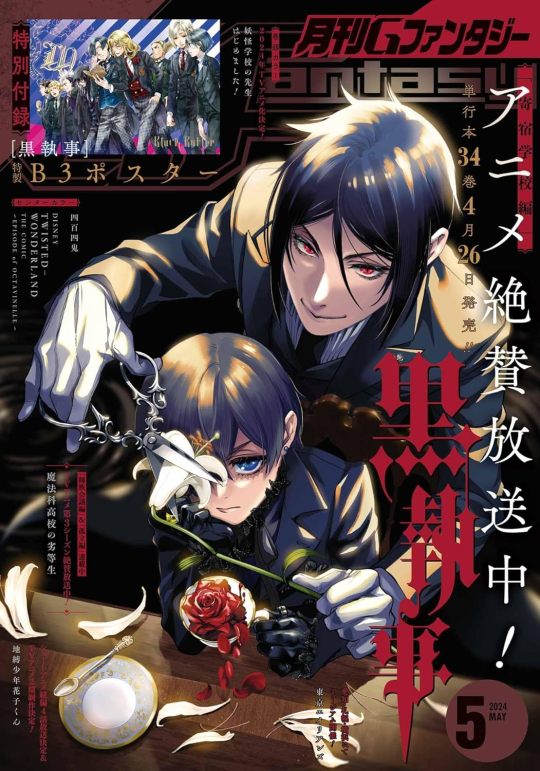
Including references, flower language, how to decode the meaning of flowers, and a little too much brainrot. As well my personal interpretation drawn from all the sources I looked at.
And of course what all of means (and maybe hints at?) for Sebastian and Ciel… and maybe even Sebaciel?
Originally posted as a twitter thread, but threads suck and I forgot a couple things. so here now.
Disclaimer :
I don’t know FOR SURE that all these things were directly referenced by Yana when creating this art. But being a fan of her work for over a decade I've become familiar with her use of symbolism and reference, and believe myself to have a good eye for it at this point!
I'm also pretty familiar with the use of flower language, including different languages, due to having been involved in a project about it and having to read wayyy too much about this.
Some of it also includes my own personal interpretation, but the meanings and info I based myself off of ARE factual. I think I made it pretty clear when referencing my personal interpretation. You're welcome to reach your own interpretation based off of the stuff provided!
And lastly, I'm not a sebaciel shipper. I'm not an anti (the complete opposite, actually) and have nothing against the ship, I like the narrative around them and how they're written but I don’t actively ship them romantically or sexually. So I'd say this is actually a pretty unbiased interpretation. Personal taste is one thing, but I don’t deny the author's intention and whats written in front of me! That is what this post is about.
Kuroshitsuji takes place in the Victorian period (1837~1901) in 1889.
The following are both important Victorian books on the language of flowers that I will be basing myself off of.
Language of Flowers by Greenaway Kate (1884), and The Language of flowers: An Alphabet of Floral Emblems (1857).
(Also, I’m treating Ciel’s rose as a deep red rose. Which is a bit different than red roses. But I am adding some relevant information about roses in general, anyway.
Now, on what they say about these flowers.




Deep rose, meaning "bashful shame". White lily, meaning "Purity and sweetness."
— The White Lily
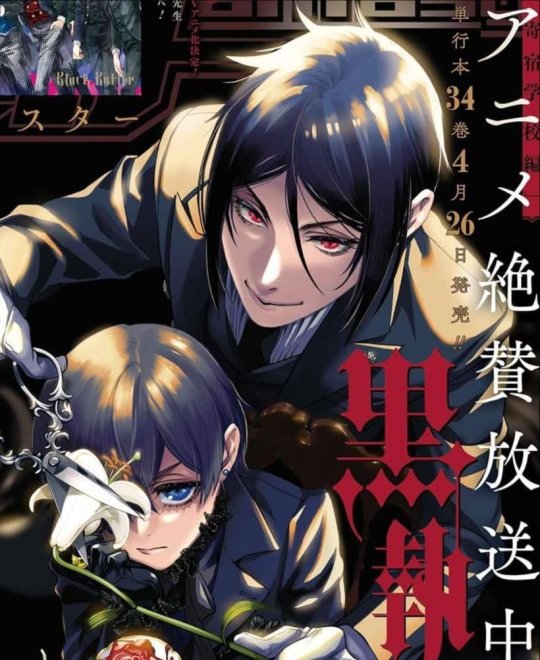
Most people assume that the lily refers to Ciel's purity, and that’s a fair assumption. But I disagree.
Firstly, the one holding the lily is Sebastian. Holding it on his right hand, tilted towards the right. However what's relevant here is the VIEWER. From the viewer's POV he's holding it to the left. Note he also holds the scissors on his left hand, where he bears HIS contract seal.
How you hold a flower, what position you give it to someone in, changes the meaning of the flower. These context clues are very important. It tells us that 'purity and sweetness' doesn’t refer to Ciel, but actually refers to Sebastian (…sorta).

This may be a little confusing. Purity and sweetness, Sebastian?! I know, I know. bear with me.
These books provide poems to help us understand how you may interpret the intended meaning. The lily poem is about enduring trials out of love because of the purity and sweetness he sees in his lover's eyes and soul. I believe Yana directly references the poems I will include in this post in her new artwork.

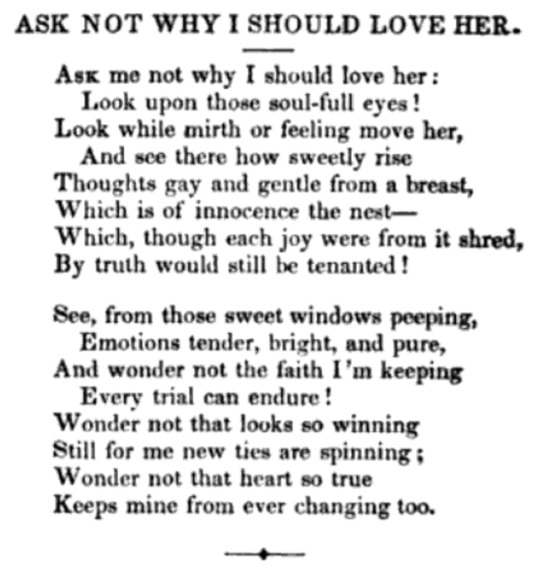
— My Interpretation
the meaning of Sebastian's lily is:

"I do all out of love for the sweetness and purity within you."
Him holding it to the contact seal and cutting the flower could stand for him destroying this sentiment (affection within himself) that has arisen in him as a result of their contract by destroying the sweetness and purity—the source of it—within Ciel (consuming his soul).
Note: This is debatable, as 'reversed' almost always means upside down. But if you consider the lily facing away from the viewer as reversed then it could mean "impurity and bitterness" which fits pretty well with Ciel, and it being held against the contract seal which is a physical representation of his impurity, brought on by his bitterness.

— The Deep Red Rose
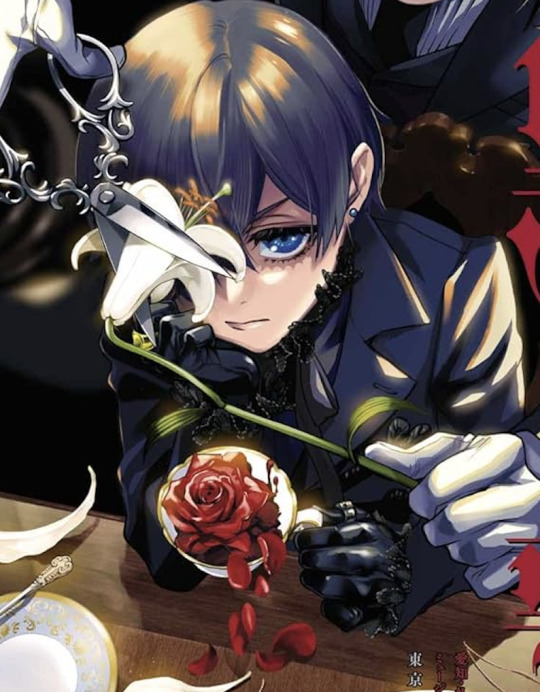
There something I find very interesting. The rose is in a teacup, standing in for tea (I think there's even tea alongside it in the cup.) From Yana herself we know that Sebastian's eyes are a reference to the reddish brown colour of tea.
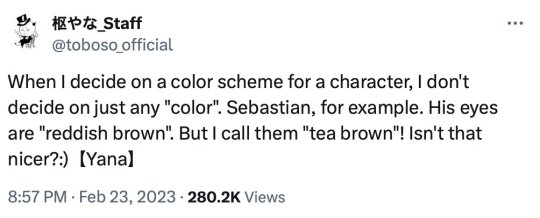
Like I said, I believe this rose to be a deep red rose, which is a bit more specific than the meaning given to red roses. However I think the poem included for roses in general very much applies here.

I was going to add my thoughts but I found this interpretation that sums it up pretty well if you replace the carpe diem theme with a more "running out of time" or "impending death" theme, which seems to be a more accurate reading for this artwork.

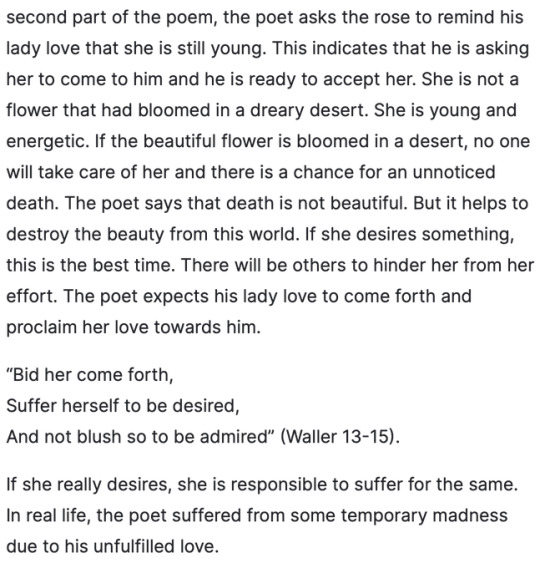
Looking at the rose itself, it has no thorns or leaves.

It is not a youthful rose as its already fully open and losing petals. "No hope, and no fear" fits with the poem, the rose is basically an hourglass referring to Ciel. His fate is unavoidable, but this isn't a deterrent. He's dancing on the ledge.

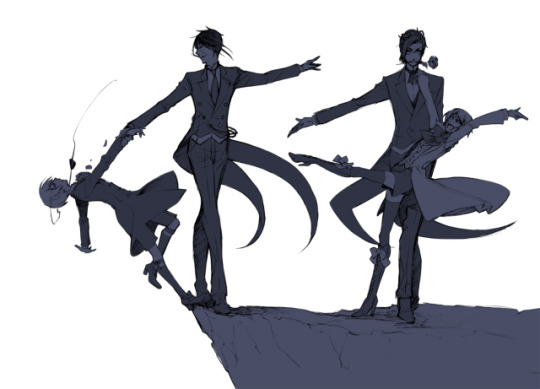
The deep red rose means 'bashful shame'.
When you compare it to the lily, which is a direct proclamation, the deep red rose is a quiet confession one cannot verbalize.
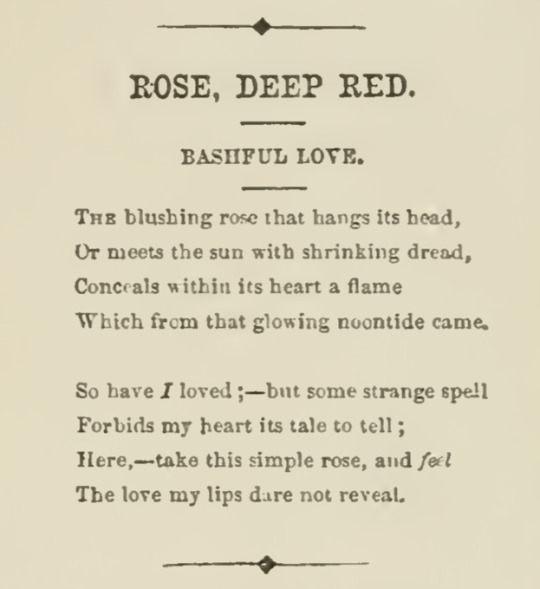
Debatable, to be fair but given the tie in to Sebastian's eye colour and the fact that he is always the one pouring tea for Ciel, I believe the Sebastian to be the speaker here too, but this time speaking on Ciel's feelings (Hence why he's the one holding it) rather than Sebastian's own.
— My Interpretation
The meaning of the deep red rose Ciel holds, speaking about Ciel's feelings of guardedness, and in response saying:
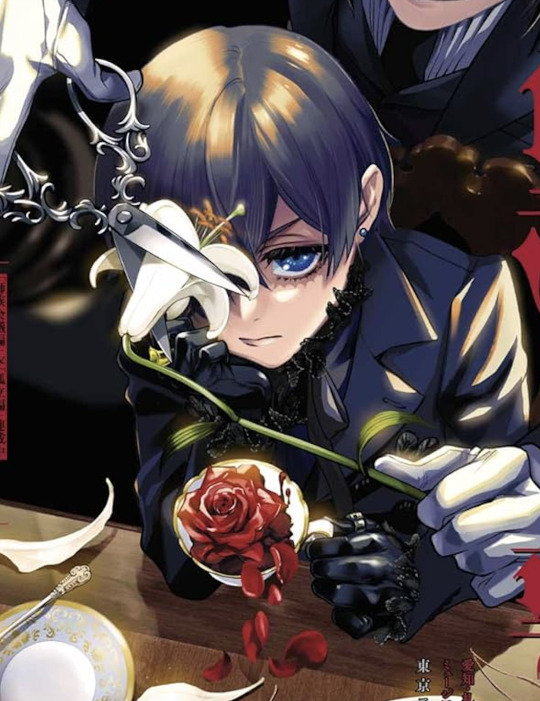
"Abandon your bashful shame, and let yourself be admired without expectations (hope) or fear"
Sebastian speaks about Ciel's feelings, the deep red rose acknowledges his feelings but they remain unspoken.
The Waller poem is a plead for his beloved to seize the day, for time is short, and allow herself to be loved completely.
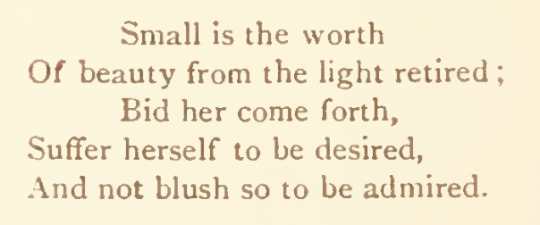
Her beauty is one to be appreciated, she is not meant to be a rose unacknowledged (unloved) in the desert.

Regarding 'expectations', I think this is more about rigid ideas of how 'appreciation' or 'admiration, might be shown or received. Sebastian and Ciel's relationship defies normality or 'expectations'. So this, too, would defy expectations a young boy like Ciel, or a traumatised boy like Ciel, may have.
From Yana herself, we know Sebastian's dedication and how highly he holds 'beauty', specifically Ciel's beauty.


The author of the poem proclaims that beauty not appreciated is not beautiful indeeed, and so he calls his beloved to come to him and be appreciated wholly during the invaluable, limited time they have.
We see the deep red rose's petals fall away, in my opinion not only symbolising the withering away of time, but also the crumbling away of this "bashful shame" that Sebastian ascribes to Ciel.
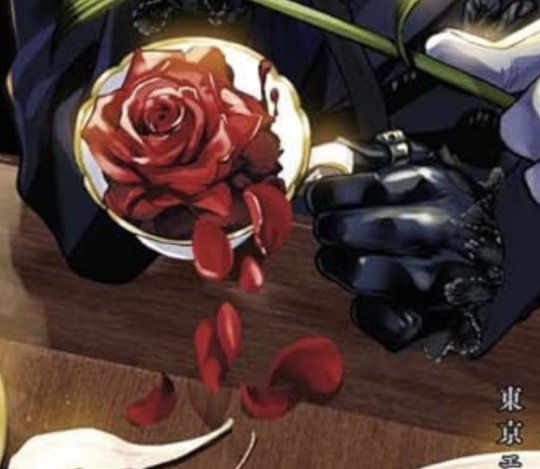
How Sebastian wishes to "appreciate" this beauty is debatable. How he wants to "admire" and "desire" (per the poem) Ciel is rather open ended. Wether it be in a romantic way, a sexual way or by consuming his soul.
However, I don’t think these are mutually exclusive. And consuming Ciel can easily be a metaphor for the former two.
— The Lily and The Rose
The Greeneaway book has this poem which im sure was directly referenced. This poem speaks about the lily and the rose in a direct power struggle and fight for dominance, until they eventually unite and reign as one.
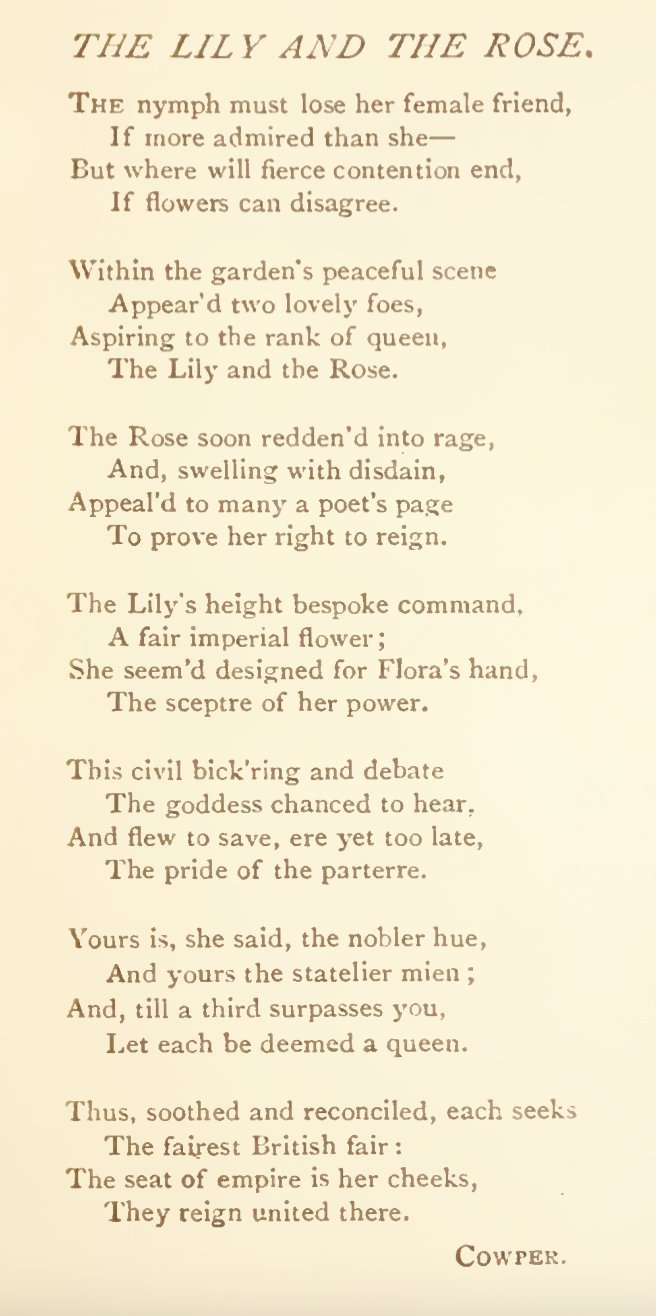
Now when speaking about this "union", you could say it refers to their contract, but I don’t think so.
The contract ties them to each other, but it doesn’t necessarily unite them. So I believe 'unity' to be about the appreciation Sebastian speaks of Ciel opening up to.
"The Lily" and "The Rose" might be interpreted as directly representing Sebastian and Ciel, and the unity that would come from them joining and becoming a truly complimentary pair. I think a power struggle and fight for being the one in control is very accurate way to describe their current dynamic in canon.
It may also be interpreted as "The Lily" and "The Rose" as being representations of their feelings and ideals previously. And then it would represent these two conflicting expressions—a loud unrelenting and destructive devotion, and a guarded, bashful, unspoken reluctance— coming together and turning from conflicting to complimentary.
Or as it tends to be with these things, both!
Either way all of this is expressed under the sense of impending doom created by their circumstances and the contract. So there's a sense of urgency permeating all of it.
Also clear to me is a sense of internal conflictedness coming from Sebastian's message that is usually only hinted at like this, and some people end up overlooking.
Sebastian desires Ciel deeply, but having him would also mean not being able to have him anymore.
Sebastian is torn and that’s why he attempts to cut the root of his wavering feelings represented by the lily.
All of this makes me wonder about what's next, and if we will see these things said more blatantly. Foreshadowing with flower language and references like this, isn't exactly rare for Yana. I wonder if we will see this 'unity' come to be, and what necessary development Sebastian and Ciel will need to undergo to make it possible. As well as what shape it will take.
I also wonder very much about Ciel's perspective in all of this, as this was almost entirely from Sebastian's POV, but I think that's intentional. Ciel has his own goals and a lot on his mind. Sebastian's goal IS Ciel. So I assume he spends a lot more time thinking about Ciel and this kind of thing.
Thank you if you read the whole way through. Like I said before, even though the sources defending it are, my interpretation is not law and you're welcome to reach your own with the things presented.
Links for sources, including free public domain PDFs of the books mentioned are found at the end of my twitter thread.
— Thanks for reading! —

#sebaciel shipper friendly post#kuroshitsuji#black butler#sebastian michaelis#ciel phantomhive#sebastian black butler#ciel black butler#sebaciel#please refrain from ship discourse on my post. I don't care if fictional characters upset you. I'm looking at the source material here.
274 notes
·
View notes
Note
Hey there sorry to bother, but I’m very interested in traditional Palestinian tattoos but I can’t find any good sources or information on them. Do you have any recommendations? Thanks so much in advance ! I’m Palestinian, but was raised so distantly from our culture I’m hungry for more if you know what I mean ♥️🇵🇸
Not a bother!
I will be honest, there really aren't many resources online that go into detail about them. A lot of information about them just hasn't been recorded and they've faded away, as older generations of Palestinians die, their tattoos and their meanings have gone with them. A lot of the Palestinians still wearing these tattoos are older Bedouin women.
I uploaded this post a few years ago with some illustrations and I answered an ask about it with some links and discussed traditional tattooing practices in West Asia between Arabs, Kurds, Assyrians, and Yazidis (there are some overlapping symbols and meanings with the tattooing throughout the region). Tattooing in Palestine is hard to document because we've been forcefully exiled all over the world. A lot of Palestinian traditions, including tattooing, were uprooted with the destruction of Palestinian society during the Nakba. There are a few different terms for it, depending on what language or what dialect of Arabic you speak, but dag/deq/dakk/daqyit are all ones I've seen used.
I also have to say that many of the meanings within the tattoos were discussed either only between the tattooer and the client or were based on one's own community or tribe. Just for example: Some tattoos or combinations of markings can distinguish a person's tribe (this is something more common for tattooed Bedouin women) or village or it could be for health, protective, religious, or cosmetic reasons. My Great-Grandmother had them for cosmetic reasons, it was just something they did in her village according to my father - sometimes tattooing is regarded to be like jewelry.
The tattooing itself would be done with a needle and the ink would be made of ink or smoke residue (sometimes breastmilk was included) and then punctured into the skin. The few articles or books I've seen it referenced in have made note that the tattooers were usually Domari artisans.
He's in the second link but I will always highlight @siinlayth 's work on cataloging tattoos in West Asia, he's a bedouin artist and has spent lots of time putting this carrd together if you'd like to browse: https://southwestasiantattoos.carrd.co/#gallery
I'll just include some more images here:



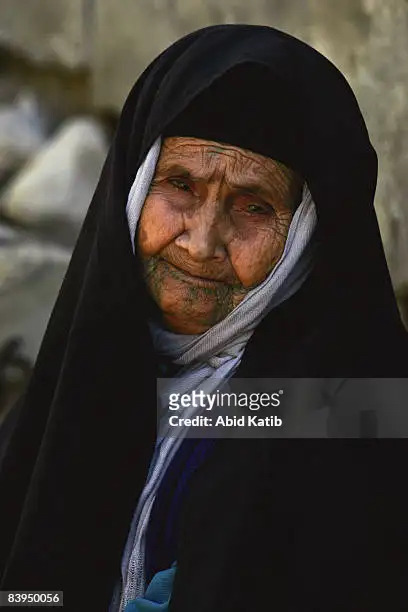




{I haven't posted about traditional tattooing in a while (none of this is directed at you butchorc) but the last time I uploaded stuff about tattooing in Palestine on my blog, I had people (who were not Palestinian in the slightest) reblogging it with tags saying it was for DND inspiration and putting information about our tattooing practices on their DND blogs for "character reference" - do not do this. Please treat our customs respectfully, this is a dying practice that we are trying to preserve- I will block anyone I see doing this.}
I hope this was at least a good starting point! I hope things go well for you and you can learn more about your culture, best wishes!
383 notes
·
View notes
Text
A writer’s guide to the historical method: how historians work with sources
In this post, I provide a brief overview of how historians engage with different types of sources, with a focus on the mindset of a historian. This insight could be valuable for anyone crafting a character whose profession revolves around history research. It may also prove useful for authors conducting research for their book.
Concept of historical source
The concept of historical source evolves over time.
Initially, the focus was mainly on written sources due to their obvious availability. However, as time has progressed, historians now consider a wide range of sources beyond just written records. These include material artifacts, intangible cultural elements, and even virtual data.
While "armchair historians" may rely on existing studies and secondary sources, true professional historians distinguish themselves by delving directly into primary sources. They engage in a nuanced examination of various sources, weaving together diverse perspectives. It's crucial to recognize the distinction between personal recollection or memory and the rigorous discipline of historical inquiry. A historical source provides information, but the truth must be carefully discerned through critical analysis and corroboration.
Here's a concise list of the types of sources historians utilize:
Notarial source
Epistolary source
Accountancy source
Epigraphic source
Chronicle source
Oratory and oral source
Iconographic source
Diary source
Electronic source
Example: a notarial source
These are documents drafted by a notary, a public official entrusted with providing legal certainty to facts and legal transactions. These documents can take various forms, such as deeds, lawsuits, wills, contracts, powers of attorney, inventories, and many others.
Here we are specifically discussing a lawsuit document from 1211 in Italy.
A medieval lawsuit document is highly valuable for understanding various aspects of daily life because in a dispute, one must argue a position. From lawsuits, we also understand how institutions truly operated.
Furthermore, in the Middle Ages, lawsuits mostly relied on witnesses as evidence, so we can access a direct and popular source of certain specific social situations.
Some insight into the methodology of analysis:
Formal examination: historians scrutinize the document's form, verifying its authenticity and integrity. Elements such as structure, writing style, language, signatures, and seals are analyzed. Indeed, a professional historian will rarely conduct research on a source published in a volume but will instead go directly to the archive to study its origin, to avoid transcription errors.
Content analysis: historians proceed to analyze the document's content, extracting useful information for their research. This may include data on individuals, places, events, economic activities, social relations, and much more. It's crucial to compile a list of witnesses in a case and identify them to understand why they speak or why they speak in a certain manner.
Cross-referencing with other sources: information derived from the notarial source is compared with that of other historical sources to obtain a more comprehensive and accurate view of the period under examination.
Documents of the episcopal archive of Ivrea
Let's take the example of a specific legal case, stemming from the documents of the episcopal archive of Ivrea. It's a case from 1211 in Italy involving the bishop of Ivrea in dispute with Bongiovanni d'Albiano over feudal obligations.
This case is significant because it allows us to understand how feudal society operated and how social status was determined.
The bishop's representative argues that Bongiovanni should provide a horse as a feudal service. Bongiovanni denies it, claiming to be a noble, not a serf. Both parties present witnesses and documents supporting their arguments.
Witnesses are asked whether the serf obligations had been endured for a long time. This helps us understand that in a society where "law" was based on customs, it was important to ascertain if an obligation had been endured for a long time because at that point it would no longer be contestable (it would have become customary).
The responses are confused and inconsistent, so witnesses are directly asked whether they consider Bongiovanni a serf or a noble. This is because (and it allows us to understand that) the division into "social classes" wasn't definable within concrete boundaries; it was more about the appearance of one's way of life. If a serf refused to fulfill his serf duties, he would easily be considered a noble by bystanders because he lived like one.
Ultimately, the analysis of the case leads us to determine that medieval justice wasn't conceived with the logic of our modern system, but was measured in oaths and witnesses as evidentiary means. And emerging from it with honor was much more important than fairly distributing blame and reason.
Other sources
Accounting source: it is very useful for measuring consumption and its variety in a particular historical period. To reconstruct past consumption, inventories post mortem are often used, which are lists of goods found in households, described and valued by notaries to facilitate distribution among heirs.
Alternatively, the recording of daily expenses, which in modern times were often very detailed, can lead to insights into complex family histories and their internal inequalities - for example, more money might be spent on one child than another corresponding to their planned future role in society.
Oral source: in relation to the political sphere, it is useful for representing that part of politics composed of direct sources, that is, where politics speaks of itself and how it presents itself to the public, such as a politician's public speech.
However, working with this type of source, a historian cannot avoid hermeneutic work, as through the speech, the politician aims to present himself to a certain audience, justify, persuade, construct his own image, and achieve results. This is the hidden agenda that also exists in the most obvious part of politics.
Iconographic source: it concerns art or other forms of "artistic" expression, such as in the case of an advertising poster. They become historical sources when it is the historian who, through analysis, confers upon them the status of a historical source. Essentially, the historian uses the source to understand aspects of the past otherwise inaccessible.
The first step in this direction is to recontextualize the source, returning it to its original context. Examining the history of the source represents the fundamental first step for historical analysis.
Diary source: diaries are a "subjective" source, a representation of one's self, often influenced by the thoughts of "others," who can be close or distant readers, interested or distracted, visible or invisible, whom every diary author can imagine and hope to see, sooner or later, reflected on the pages of their writing.
Furthermore, they are often subject to subsequent manipulations, and therefore should be treated by historians only in their critical edition; all other versions, whether old or new, foreign or not, are useful only as evidence of the changes and manipulations undergone over time by the original manuscripts.
Electronic source: historians use Wikipedia even if they often don't admit it out loud.
This blog is supported through tips here on Tumblr. If you’d like to support me, please consider giving a tip.
#writing advice#writing help#writing reference#writing tips#creative writing#fantasy worldbuilding#fantasy writing#worldbuilding#worldbuilding tips
311 notes
·
View notes
Text

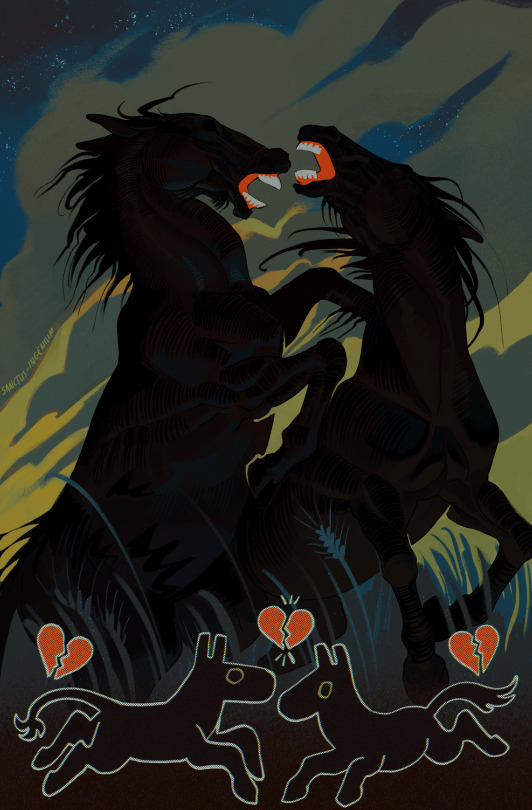




another one of these posts lol... sketches vs final. not much changed for these ones, i kind of went into them with a very solid mental image already in my head. all of these were done start to finish in procreate
thoughts below the cut
horse fight .... this is based off a really really beautiful sky i saw while driving home one evening. i'm really proud of getting the colours i saw exactly right, this kind of greenish yellow fading to dark blue and with grey clouds low over it that looked very dark against the yellow by the horizon, but very pale against the dark blue.
i thought it would be a cool backdrop to draw a scene i've been thinking about for a while. The little cartoony horses are there to provide some tonal whiplash but also because these are two immortal shapeshifters who can fight violently without it being a huge deal. the little horses represent the actual gravity of the fight (that is, kind of a slap fight between two drama queens) which contrasts with the visuals of two animals brutally tearing at eachother. also i got the two horses at the bottom mixed up, Pascal is the one with the skinny plumed tail and Macha has a more traditional horse tail and i put them on the wrong sides.
i had a LOT of trouble shading this. i didn't want the horses to be too shiny but that meant a much lower contrast in shading and even with my screen brightness turned up i could barely see what i was doing. but i wanted it to read as realistic. mixed results i think. if i did it again i might try a different shading style because this one didn't really do it for me
--
spooky van!!! the post i deleted by accident (rip. i will repost it soon). this is a picture of the barrow (the field) taking a different shape - in this case a cool van. the van contains every single thing the field does (including the human victims that get lost in there...) but compressed down into a manageable shape. the void is Pascal because the field is inside him. he did this for his human bf to provide novel way to travel through the Otherworld. don't ask how this works like, spatially, because the answer is: i don't do hard magic systems in this setting
i loooove shading things with pencil hatching and i really like contrasting it with smooth colours/shading so that's mainly what i did here. it was simple enough. the van is of course heavily referenced and i wish i had been able to stylise it a little more.. maybe next time. i want to draw a kind of cutaway illustration of the van showing exterior and interior (like an old blueprint schematic), which i might use as a cover for the book/comic/whatever but that will require a very intimidating level of precision so i think i'll work up to that.
--
RUA magazine. this is my third time doing a rua magazine cover (first time posting tho). this is an in-universe magazine distributed throughout the Otherworld to an audience of fairies. in the sketch, the illustation was originally the King of Pentacles tarot card (the pentacle being the disco ball). but i decided to make a different King of Pentacles card for him instead, since I try hard to move away from symmetrical composition for the tarot cards (it's boring). so i repurposed this one into another magazine cover. like i said Pascal is a self-absorbed attention whore and has a habit of giving bullshit interviews just so that he can be on the cover as much as possible. he dresses like this all the time (the year is 2017)
the disco ball took 15 years off my life and it's not even the first disco ball i've drawn! i finished my actual king of pentacles card before i finished the rua cover sketch, so i can show u this

which is much better even if i did reference so heavily that it isn't exactly stylised. but this card needs some serious revision before i even think about posting it. i'm just not happy with his face.
original intent was for it be mysterious with emphasis on the neon lights but it ended up far more suggestive than i expected. that's life!
4K notes
·
View notes
Text
Here's a compilation of every Jesus foreshadowing I could find so far in Good Omens s1 and s2. This also includes my notes on what these hints may be referencing to (based on the Book of Revelation as the source material we will be parodying for s3, plot hints about 668: Neighbor of the Beast that were dropped over the years, and finally the themes and motifs that had been established in s1 and s2.)
When put together, it's actually incredible how much his character had already been foreshadowed in the past two seasons.
#good omens#good omens 2#good omens 3#ineffable husbands#aziracrow#aziraphale#crowley#good omens meta#i can yap about jesus in go 3 all day
365 notes
·
View notes
Note
I really don't like how Melinoe looks like a female Hades with Persephone's pink eyes. It's too generic. Maybe keep her hair and eye colors, but maybe make her skin color a blend of both of them, like a muted purple/gray to contrast her with Dionysus? Anything other than what she has in canon.
What's wild is that the narrative is trying to convince us now that all of the dreams he had of him and Persephone were just peeks into the future. But if that's the case-



1.) Melinoe learns to communicate verbally at some point
2.) There's ANOTHER BABY we haven't even established yet (though Rachel did confirm in a tweet from ages ago that it's some god named Brimos who she read about in a book when she was a kid ???):

(but Brimo was an epithet associated with Hecate/Persephone/other gods of the dead, not necessarily an actual direct offspring of H x P, so... yeah, weird choice of a 'nod' especially now that she's trying to implement Hades' dreams into the plot as 'future sight' or w/e)
3.) All of the visions of their future together feature children that predominantly resemble Hades, not Persephone. This is really telling as to how much the relationship - both on a narrative level and even a visual one - revolves around Hades. Persephone is just an accessory, to the point that none of their children can resemble her in any major way, only through very miniscule references, such as the vines coming out of Melinoe's back and her pink eyes (whereas "Brimos" doesn't resemble her at all).
4.) This goes hand-in-hand with #3, but Dionysus and Thanatos are not present in any of these visions. I'm willing to give Thanatos a pass because he's an adult man (although it does just go to show how little Hades views him as a child), but what about Dionysus? Does his absence from these scenes tell us that Persephone found other accommodations for him? Or, more likely, is it because Rachel never planned to include Dionysus in the first place? And of course, Dionysus' design is also inherently linked to Hades, because while he has purple skin (referencing wine/grapes/etc.) he's got white hair that's explained as a genetic trait that's been passed down through Hades.
All that said, the baby plotlines in LO are a mess in and of themselves, and you can tell just how much of it revolves around Persephone "fixing" Hades or being the solution to all of his infertility and relationship problems. Persephone is the most perfect woman of all who Hades is dependant on to solve all of his problems, everything is about what she can provide him and what he can stand to gain from her, even if it means dragging her down to his level.
Man. Minthe was right.

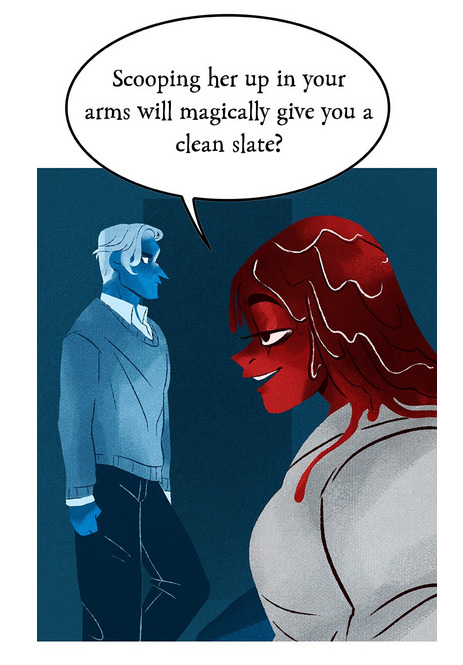


(seriously in ANY other story this would have been FORESHADOWING-)
#ask me anything#ama#anon ama#anon ask me anything#anti lore olympus#lore olympus critical#lo critical
266 notes
·
View notes
Text
Misunderstanding
I received a note from someone who was upset I “failed to cite Scott McCloud’s Understanding Comics” in my research for my work on Neil Gaiman's Chivalry and the essays I wrote about it.
I really appreciate that people want to make sure credit goes where it's due, and I have a lot of respect for Scott McCloud's accomplishment with his wonderful book.
I haven't read it myself in some years, and didn't cite it in my articles because I didn't reference it. I don't even know where my copy is so I don't know what McCloud referenced, either.
The information in my articles re: illuminated manuscripts and the Bayeux Tapestry, as well as other theories about the development of sequential art from prehistory, not only predate McCloud's work (and in fact, predate McCloud's birth,) but they are so common and so well known in comics circles that asking me to cite them seems as weird to me as asking me to cite the information that George Washington was the first President of the United States.
A part of me wonders if someone is trying to play, "Let's you and him fight."
No.
But I’m happy to bring to your attention some reading material.
Stephen Becker in his 1959 work Comic Art in America: A Social History of the Funnies, the Political Cartoons, Magazine Humor, Sporting Cartoons, and Animated Cartoons was among the first to discuss the Bayeux Tapestry as comic art. I read that book sometime in the 1980’s. I think a lot of people assume the Bayeux tapestry as comic art was McCloud’s idea, but we don’t all walk around with a reference library in our heads, so there you go. I can’t find my copy of Becker’s work to quote, but I did find an article by Arthur Asa Berger with a mention of the Bayeux Tapestry as comic art in the summer 1978 issue of The Wilson Quarterly.

My first exposure to the idea of comics as descendant of fine art was Maurice Horn’s 1976 The World Encyclopedia of Comics which was my first read re: comics history. I still have my tattered 1976 edition.
While Horn scorned the idea that tapestries and manuscripts could be comic art (see, it was a matter of discussion way back then, so much so that authors were writing snarky asides to one another about it,) he believed the origin of sequential art was in the Renaissance sketches of Leonardo da Vinci - which I think everyone now agrees is kind of a bonkers idea.

I think Horn was just intent on elevating the comic art form by hooking up with da Vinci.
You go, boi.
Comics as descendant of art on scrolls is a very common theory, the easiest to trace being in Manga! Manga! The World of Japanese Comics by Fred Schodt published in 1983 when I was still a teenager. I can't find my copy to show examples, but this text is still in print and you can go read it for yourself.
I was introduced to manga by cartoonist Leslie Sternbergh and bought Schodt’s book at Books Kinokuniya on (I think) a trip to New York around the time of first publication of Schodt’s work. And years later took a trip to Japan with Fred Schodt and a group of cartoonists including Jeff Smith and Jules Fieffer, Nicole Hollander, and Denys Cowan as the guests of Tezuka Productions.
Here we all are.

So, I’m familiar with manga, see.
As for comics as descendant of cave paintings, hieroglyphics and ancient art in general, Will Eisner’s 1985 Comics and Sequential Art not only made all of those points, but made those points with comic art examples. Like these.

And this.

And this.
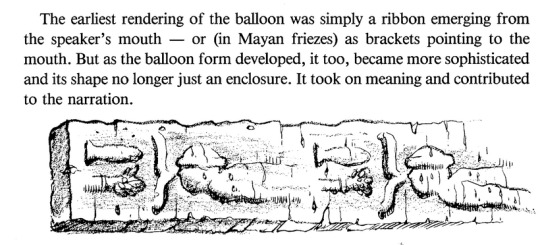
And more than a few words on this:


I find it amusing that someone is questioning why I didn’t cite McCloud when what you should probably be questioning is why more people don’t cite Eisner who produced his book eight years before McCloud published his and who is well known to have influenced McCloud.
Whatever. My book's autographed.
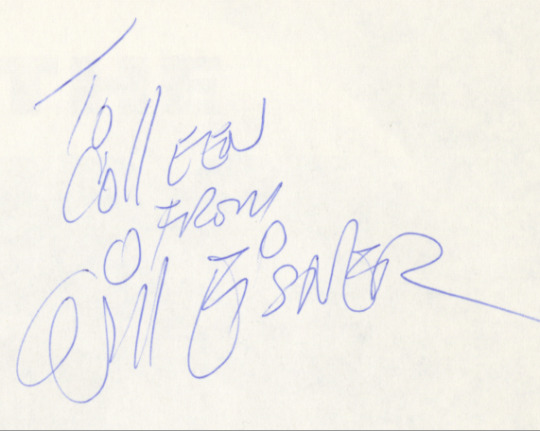
I also danced with Eisner. Eat your heart out.

Understanding Comics is a terrific work with huge advantages over every book (that I know of) about comics that came before: it taught comics entirely in the language of comics.
But the discussion in it about the origins of comics and my work especially re: illuminated manuscripts/tapestries, did not originate with McCloud. I research illuminated manuscripts because it’s my hobby and it informs my art.
I encourage everyone to read Understanding Comics because it is an outstanding work.
But it’s not the book that introduced me to the concepts of the development of comic art. It’s not even the point of origin of those concepts. So, there is no reason to cite it.
Also, shocking as it may seem, I occasionally come up with ideas on my own. While I'm younger than McCloud, I've actually been a comics pro longer than he has. So I've had plenty of opportunity to, you know, read things and toss things around, and decide for myself.
When I first read Chivalry and first begged Neil Gaiman to let me adapt it, my head full of the work of Alberto Sangorski and his art for Tennyson’s Le Morte D’Arthur, Understanding Comics hadn’t been published yet.
It's been a good twelve years since I last read McCloud's work, and I don't think I've spoken to him five times in the last three decades. But I'm pretty sure he never mentioned Sangorski.
I hope that clears everything up, and maybe introduces some of you to some works you might not be aware of.
Have a great day.
#understanding comics#comics history#neil gaiman#scott mccloud#chivalry#jules fieffer#tezuka productions#manga#will eisner
2K notes
·
View notes
Note
I read the post where you answered why you didn’t like Malleus and remembered that you placed Leona really highly on your favs list, and Leona is my favorite so do you mind me asking why do you like Leona?
[My TWST character tier list is here.]
[Anon is also referencing this Malleus post.]


THERE’S A REASON WHY L*ONA IS IN “Unfortunately Enjoy” TIER 😭 I think for like... over a year (2020-2021)? Probably closer to 1.5 years?? I really disliked him and swore up and down that I'd "never in my life simp for the fake cat". This was largely in part due to book 2, which to this day I believe did Leona a HUGE disservice and made him look very unintelligent and uninteresting. Then I was drip fed new Leona content as it steadily came out (vignettes, voice lines, event stories, his return in book 6) and my opinion of him vastly improved. Book 2 was just a really bad introduction to him and it greatly soured my first impressions. sjfyofqebfeiafns B-But now I'm too embarrassed to openly declare, "Yeah, I like a sad muscular l*on man. So what?"
Some would say that's tsundere behavior... BUT I SAY I'M COMPLETELY JUSTIFIED FOR ACTING THIS WAY BECAUSE IT ISN'T EASY TO CONFESS WITH YOUR WHOLE CHEST THAT YOU LIKE KINGSCHOLAR OF ALL TWST CHARACTERS
... Anyway! For a much more expanded explanation, I'd recommend this post! It already states a lot of my thoughts, and I don't want to repeat them in yet another lengthy lion-related post. What I'll do instead is summarize the key points for you, plus add some commentary about Leona and Malleus at the end.
Admittedly, he is pretty. VERY pretty. I'm saying this as someone who normally really dislikes hair longer than shoulder length, the "wild"/bad boy aesthetic, and kemonomimi. Leona breaks ALL the rules and still somehow manages to wear everything and anything well because of his sheer confidence and natural grace. His physical features are also very striking... The sharp bright green eyes, the small waist and large chest (there's NO reason why he HAD to be built like that), his stupid smirk, etc.
His pettiness and sarcasm. Leona has, hands down, some of the funniest lines 🤡 I love that he has the balls to speak callously to everyone, including fellow dorm leaders and royalty. His best moments, however, are when he whips out the sarcasm on statements which are so patently untrue--like when he says he is a 'delicate prince' and a 'lost child', both moments from book 6. It's also hilarious whenever Leona speaks in a formal way, showing that he does have the education and the knowledge of how a prince should present himself, but just actively chooses to not make the effort and only does so mockingly or when social grace calls for it.
HIS BIG BRAIN FOLDS, HOLY COW (err, book 2 aside). Leona works smarter, not harder!! He's always one step ahead of everyone else, even if he appears sleepy or disinterested at the time. He figured out the trick behind the "indestructible" golden contracts, he sussed out Jamil WAY before book 4 ever came out (saying that Jamil has "eyes that always glare" and implying that Jamil poses a threat to Kalim's life; this is from Jamil's School Uniform vignette), he takes what he learns in textbooks and so easily translates it to real-world experiences (ie advising the first years on how to more efficiently mine magestones in Vargas Camp), etc. Additionally, Leona knows when to step in and when to be hands off. It's not done out of cowardice or laziness, but rather because he's thinking strategically. For example, he could have resisted capture at the hands of the Ferrymen, but he didn't because it would be smarter to just go with them willingly. It saves everyone a lot of time and energy, and it’s this kind of intelligent thinking that makes Leona really stand out.
He knows how to lead. There are many different types of beastmen, each with own beliefs, values, and traditions that are unique to their own group. As a result, it is very difficult to unify all beastmen within the Sunset Savanna under one rule. Guess who doesn't have this problem? THAT'S RIGHT, IT'S LEONA. There's a variety of beastmen in Savanaclaw, and he effortlessly rules over them and commands their respect.
He actively thinks about how to improve the Sunset Savanna. Leona's ideas are not always the best (like, yeah, you could introduce new technology to the country but expect significant social pushback from the people, who prioritize living in harmony with nature). However, I can really appreciate that he did not entirely turn his back on the people who feared his powers and talked him down. I think he eventually realized the flaws in his way of thinking and actively chose an energy and mining lab internship in hopes of researching ways to slowly implement changes that will benefit the Sunset Savanna while also remaining respectful of the people's beliefs. He is concerned about Falena's lax way of ruling and consistently brings up ideas in various voice lines about how they can improve the Sunset Savanna and its relationships with other countries and tourists. In spite of everything he went through, Leona never wants to hurt those who hurt him with their comments and comparisons to his elder brother. He does not ever want to tear down the system that kicked him down again and again, only wants to challenge it by proving his own merits and the merits of the other downtrodden that he leads.
As much as he wants to deny it, he cares about his underclassmen and goes out of his way to help them. There are sooo many examples of this that it cannot possibly fit in one bullet point. (I would really recommend reading the elongated post linked above, as I go into more detail on this.) Suffice to say, Leona has been shown guiding, instructing, and mentoring many other characters including, but not limited to: Epel, Ruggie, Jack, and various Savanaclaw mob students. This really hits me in the heart because I love reliable big brother characters 😭 EVEN THOUGH LEONA IS TECHNICALLY A YOUNGER BROTHER...
He understands his strengths—and he understands others' strengths too. This man is fully aware of his magical might and powerful presence. He uses every last bit of it to full effect and to attain his goals, whatever those may be. One of my favorite uses has to be In Fairy Gala!! He distracted some pixies by simply demanding water and their attention so his partners in crime could escape—and what’s more, this was a plan he came up with on the spot because their mission was being jeopardized by unforeseen events. Leona is also good about pinpointing people’s best attributes and then helping them hone it. This happens a lot during club practice, bur it also occurs in book 6 between him and Jamil. Speaking of…
THAT WHOLE BOOK 6 CONVERSATION WITH JAMIL DESERVES ITS OWN BULLET POINT. This part was peak mentor mode Leona 😭 Sure, maybe he wasn’t the kindest with his wording, but I felt this was the wake up call Jamil needed to hear. What really got me though was the part where Leona tells Jamil there’s still hope for him… “unlike me”. (I believe this part was translated differently in EN to make Leona’s ego sound more inflated (ie “I’m not like you”) which saddens me immensely.) It paints the image that Leona is still struggling to believe his efforts will amount to anything and that he believes more in his juniors than in himself :(( (which informs my headcanon that Leona mentors younger students so that they can have the bright future he doesn’t think he can have for himself).
Emotional complexity. When you get down to it, what started off as a very basic story of jealousy and inferiority complex actually resulted in a deeply flawed, traumatized, and scarred individual who continues to doubt and put himself down but is slowly recovering. Leona is smart and charismatic—he is everything a leader should be, but he doesn’t truly see his own worth. (Ironically, the only people who do are the ones who look up to him and follow him.) And now… Leona’s actually got his eyes set on graduating! He has his internship plans set! I think he’s made such big strides since book 2, and it’s been so rewarding seeing him regain his willingness to try and succeed return to him.
Looking back on it, it’s so ironic how things ended up working out. Initially, I was totally on Lilia’s side when he insulted Leona and said he would never be the kind of leader Malleus is. Now I’m realizing how Leona does many of the things I don’t see Malleus doing (despite Lilia claiming Malleus is more fit to be king than Leona is).
Malleus isn’t harming his people by any means, but it’s more like he’s… stagnant? Complacent? He’s satisfied with the status quo and is comfortable resting on his laurels. And because of that, Malleus doesn’t really seem to consider what he, as a leader, can do for others, be it for his dorm members or doe his country. (Part of this is also how isolated and opposed to change Briar Valley is, of course! That kind of culture definitely shapes Malleus’s thinking.) He tends to avoid situations which involve navigating social complexities rather than dealing with them himself. Think of Ghost Marriage, when Sebek proposes in his place. Think of Fairy Gala, when Silver is the one that ultimately resolves the conflict between the diurnal fae (who have historically not been friendly with nocturnal fae) and NRC. Malleus is so sheltered that has not truly been put in situations where he has to make tough decisions or where he has been challenged. He has never had to claw and scream and beg for people to see his worth.
Leona has been through that emotional wringer, and though he’s been hurt so badly, he still came out the other side. In running from the shadow of his family—of his older brother—Leona found solace in this new kingdom, Savanaclaw. It’s a place to build himself up, to stew over the ideas he has that have yet to be realized, all with a safe mental distance from home. It’s through the many hardships he has experienced that has refined his wit and given it a place to practice, to be used.
When it comes down to it, Leona and Malleus are two sides of the same coin. Both arrogant princes, the second born and crown prince, respectively, wishing for the other’s circumstances. Leona desperately wants that respect and recognition that Malleus has. Malleus longs for the intimacy and camaraderie that Leona is so easily able to cultivate and command. Leona has been forced to adapt, to learn, to grow from his scars. Malleus struggles with the concept of change (understandable, given his background) and actively denies reality if he finds the truth to be unpleasant. He’s not used to facing dilemmas that cannot be solved with magical strength, and has not ever been challenged in such a way. Malleus doesn’t know how to deal with that, which is partly why be panics and loses himself to emotions in book 7. (By the end of it, I’m sure he’ll be given the chance to see the error of his ways though 💦 or at least I hope he does??)
Their characters are very different, and that’s not a bad thing!! If anything, it makes their dynamic so interesting to observe and it offers varying interpretations of the same “prince” trope. I definitely know which of the two I prefer 🤡
#twisted wonderland#twst#Leona Kingscholar#disney twisted wonderland#disney twst#book 2 spoilers#notes from the writing raven#question#book 6 spoilers#Jamil Viper#vargas camp spoilers#fairy gala spoilers#Falena Kingscholar#Farena Kingscholar#book 7 spoilers#twst en#twisted wonderland en#advice#Epel Felmier#Jack Howl#Ruggie Bucchi#Savanaclaw#Lilia Vanrouge#Malleus Draconia#Sebek Zigvolt#Silver#Diasomnia#NOT L*ONA ROT
230 notes
·
View notes